Σύνδεση
Αναζήτηση
Πρόσφατα Θέματα
Παρόντες χρήστες
3 χρήστες είναι συνδεδεμένοι αυτήν την στιγμή:: 0 μέλη, 0 μη ορατοί και 3 επισκέπτες Κανένας
Περισσότεροι χρήστες υπό σύνδεση 28, στις Τετ Ιαν 25, 2017 1:10 am
Clock
Astronomy Picture of the Day
Σελίδα 6 από 15
Σελίδα 6 από 15 •  1 ... 5, 6, 7 ... 10 ... 15
1 ... 5, 6, 7 ... 10 ... 15 
 2017 April 22
2017 April 22
2017 April 22
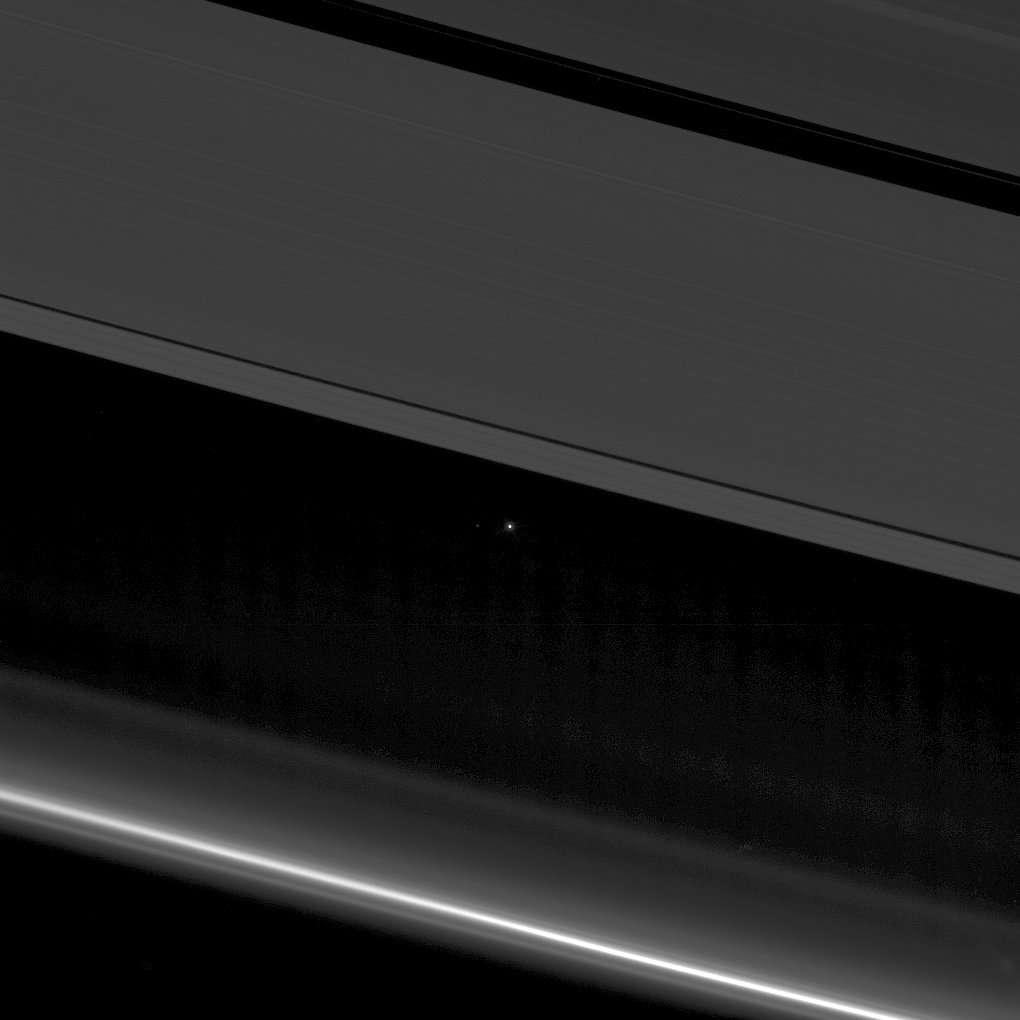
Between the Rings
Image Credit: Cassini Imaging Team, SSI, JPL, ESA, NASA
Explanation: On April 12, as the Sun was blocked by the disk of Saturn the Cassini spacecraft camera looked toward the inner Solar System and the gas giant's backlit rings. At the top of the mosaicked view is the A ring with its broader Encke and narrower Keeler gaps visible. At the bottom is the F ring, bright due to the viewing geometry. The point of light between the rings is Earth, 1.4 billion kilometers in the distance. Look carefully and you can even spot Earth's large moon, a pinprick of light to the planet's left. Today Cassini makes its final close approach to Saturn's own large moon Titan, using Titan's gravity to swing into the spacecraft's Grand Finale, the final set of orbits that will bring Cassini just inside Saturn's rings.

Between the Rings
Image Credit: Cassini Imaging Team, SSI, JPL, ESA, NASA
Explanation: On April 12, as the Sun was blocked by the disk of Saturn the Cassini spacecraft camera looked toward the inner Solar System and the gas giant's backlit rings. At the top of the mosaicked view is the A ring with its broader Encke and narrower Keeler gaps visible. At the bottom is the F ring, bright due to the viewing geometry. The point of light between the rings is Earth, 1.4 billion kilometers in the distance. Look carefully and you can even spot Earth's large moon, a pinprick of light to the planet's left. Today Cassini makes its final close approach to Saturn's own large moon Titan, using Titan's gravity to swing into the spacecraft's Grand Finale, the final set of orbits that will bring Cassini just inside Saturn's rings.

panosol- Αριθμός μηνυμάτων : 762
Points : 927
Reputation : 15
Ημερομηνία εγγραφής : 17/06/2012
Ηλικία : 56
 2017 April 23
2017 April 23
2017 April 23
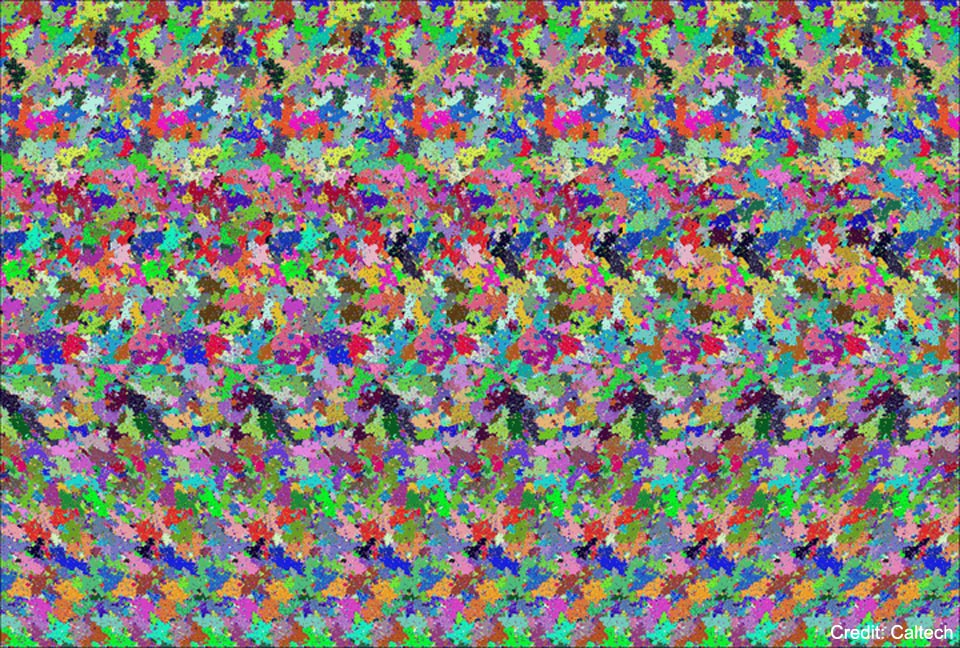
The Holographic Principle
Image Credit: Caltech
Explanation: Is this picture worth a thousand words? According to the Holographic Principle, the most information you can get from this image is about 3 x 1065 bits for a normal sized computer monitor. The Holographic Principle, yet unproven, states that there is a maximum amount of information content held by regions adjacent to any surface. Therefore, counter-intuitively, the information content inside a room depends not on the volume of the room but on the area of the bounding walls. The principle derives from the idea that the Planck length, the length scale where quantum mechanics begins to dominate classical gravity, is one side of an area that can hold only about one bit of information. The limit was first postulated by physicist Gerard 't Hooft in 1993. It can arise from generalizations from seemingly distant speculation that the information held by a black hole is determined not by its enclosed volume but by the surface area of its event horizon. The term "holographic" arises from a hologram analogy where three-dimension images are created by projecting light though a flat screen. Beware, other people looking at the featured image may not claim to see 3 x 1065 bits -- they might claim to see a teapot.

The Holographic Principle
Image Credit: Caltech
Explanation: Is this picture worth a thousand words? According to the Holographic Principle, the most information you can get from this image is about 3 x 1065 bits for a normal sized computer monitor. The Holographic Principle, yet unproven, states that there is a maximum amount of information content held by regions adjacent to any surface. Therefore, counter-intuitively, the information content inside a room depends not on the volume of the room but on the area of the bounding walls. The principle derives from the idea that the Planck length, the length scale where quantum mechanics begins to dominate classical gravity, is one side of an area that can hold only about one bit of information. The limit was first postulated by physicist Gerard 't Hooft in 1993. It can arise from generalizations from seemingly distant speculation that the information held by a black hole is determined not by its enclosed volume but by the surface area of its event horizon. The term "holographic" arises from a hologram analogy where three-dimension images are created by projecting light though a flat screen. Beware, other people looking at the featured image may not claim to see 3 x 1065 bits -- they might claim to see a teapot.

panosol- Αριθμός μηνυμάτων : 762
Points : 927
Reputation : 15
Ημερομηνία εγγραφής : 17/06/2012
Ηλικία : 56
 2017 April 24
2017 April 24
2017 April 24

A White Battle in the Black Sea
Image Credit: NASA, Aqua, MODIS
Explanation: Trillions have died in the Earth's seas. Calcified shields of the dead already make up the white cliffs of Dover. The battle between ball-shaped light-colored single-celled plants -- phytoplankton called coccolithophores -- and even smaller, diamond-shaped viruses dubbed coccolithoviruses -- has raged for tens of millions of years. To help fight this battle, the coccolithophores create their chalky armor by absorbing carbon dioxide from the atmosphere. This battle is so epic that coccolithophores actually remove a significant fraction of Earth's atmospheric carbon dioxide, bolstering the breathability of air for animals including humans. Pictured in this 2012 image from NASA's Aqua satellite, the Black Sea was turned light blue by coccolithophore blooms.

A White Battle in the Black Sea
Image Credit: NASA, Aqua, MODIS
Explanation: Trillions have died in the Earth's seas. Calcified shields of the dead already make up the white cliffs of Dover. The battle between ball-shaped light-colored single-celled plants -- phytoplankton called coccolithophores -- and even smaller, diamond-shaped viruses dubbed coccolithoviruses -- has raged for tens of millions of years. To help fight this battle, the coccolithophores create their chalky armor by absorbing carbon dioxide from the atmosphere. This battle is so epic that coccolithophores actually remove a significant fraction of Earth's atmospheric carbon dioxide, bolstering the breathability of air for animals including humans. Pictured in this 2012 image from NASA's Aqua satellite, the Black Sea was turned light blue by coccolithophore blooms.

panosol- Αριθμός μηνυμάτων : 762
Points : 927
Reputation : 15
Ημερομηνία εγγραφής : 17/06/2012
Ηλικία : 56
 2017 April 25
2017 April 25
2017 April 25
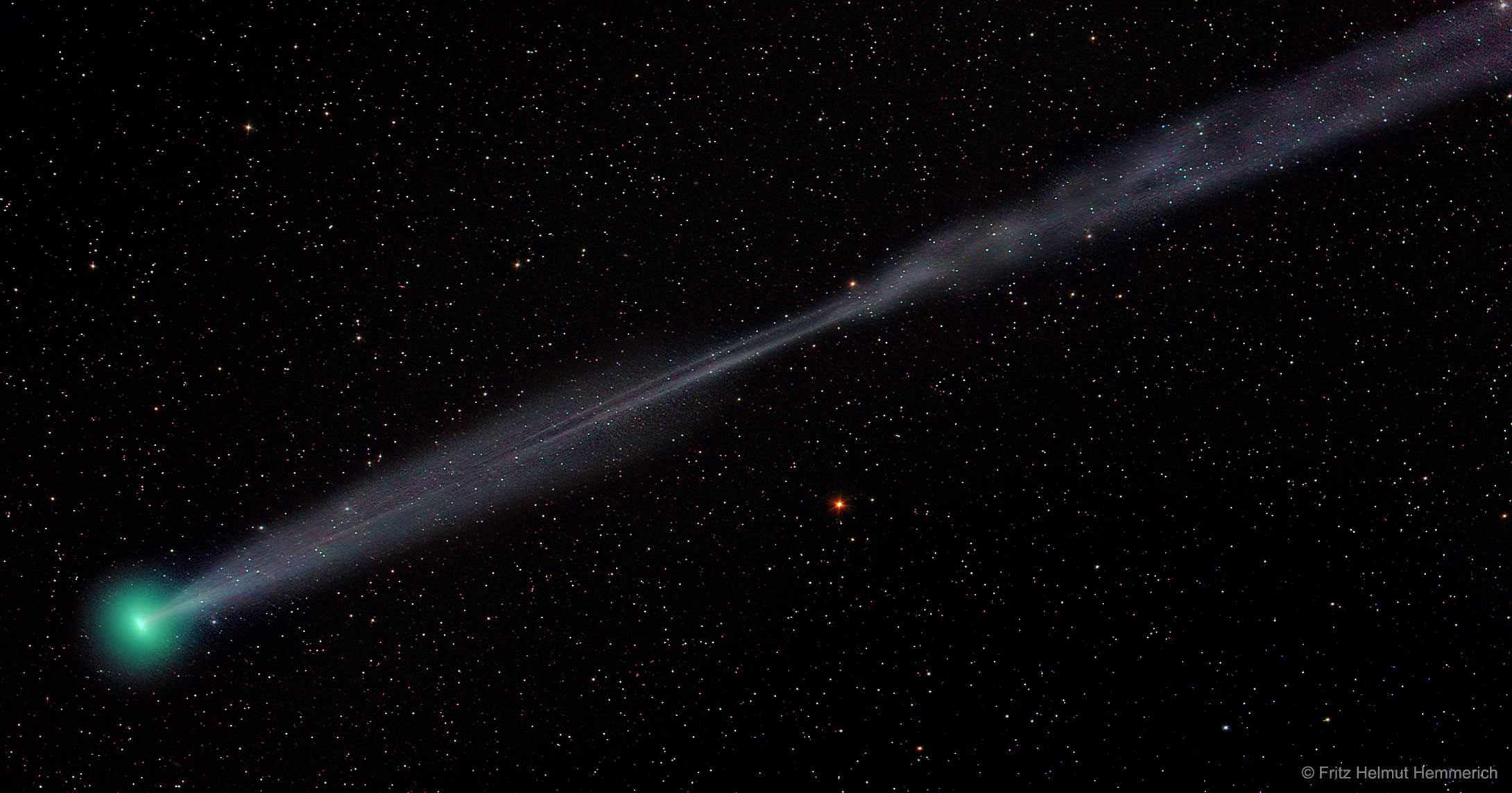
A Split Ion Tail for Comet Lovejoy E4
Image Credit & Copyright: Fritz Helmut Hemmerich
Explanation: What's happened to Comet Lovejoy? In the pictured image, a processed composite, the comet was captured early this month after brightening unexpectedly and sporting a long and intricate ion tail. Remarkably, the typically complex effect of the Sun's wind and magnetic field here caused the middle of Comet Lovejoy's ion tail to resemble the head of a needle. Comet C/2017 E4 (Lovejoy) was discovered only last month by noted comet discoverer Terry Lovejoy. The comet reached visual magnitude 7 earlier this month, making it a good target for binoculars and long duration exposure cameras. What's happened to Comet Lovejoy (E4) since this image was taken might be considered even more remarkable -- the comet's nucleus appeared to be disintegrating and fading as it neared its closest approach to the Sun two days ago.

A Split Ion Tail for Comet Lovejoy E4
Image Credit & Copyright: Fritz Helmut Hemmerich
Explanation: What's happened to Comet Lovejoy? In the pictured image, a processed composite, the comet was captured early this month after brightening unexpectedly and sporting a long and intricate ion tail. Remarkably, the typically complex effect of the Sun's wind and magnetic field here caused the middle of Comet Lovejoy's ion tail to resemble the head of a needle. Comet C/2017 E4 (Lovejoy) was discovered only last month by noted comet discoverer Terry Lovejoy. The comet reached visual magnitude 7 earlier this month, making it a good target for binoculars and long duration exposure cameras. What's happened to Comet Lovejoy (E4) since this image was taken might be considered even more remarkable -- the comet's nucleus appeared to be disintegrating and fading as it neared its closest approach to the Sun two days ago.

panosol- Αριθμός μηνυμάτων : 762
Points : 927
Reputation : 15
Ημερομηνία εγγραφής : 17/06/2012
Ηλικία : 56
 2017 April 26
2017 April 26
2017 April 26
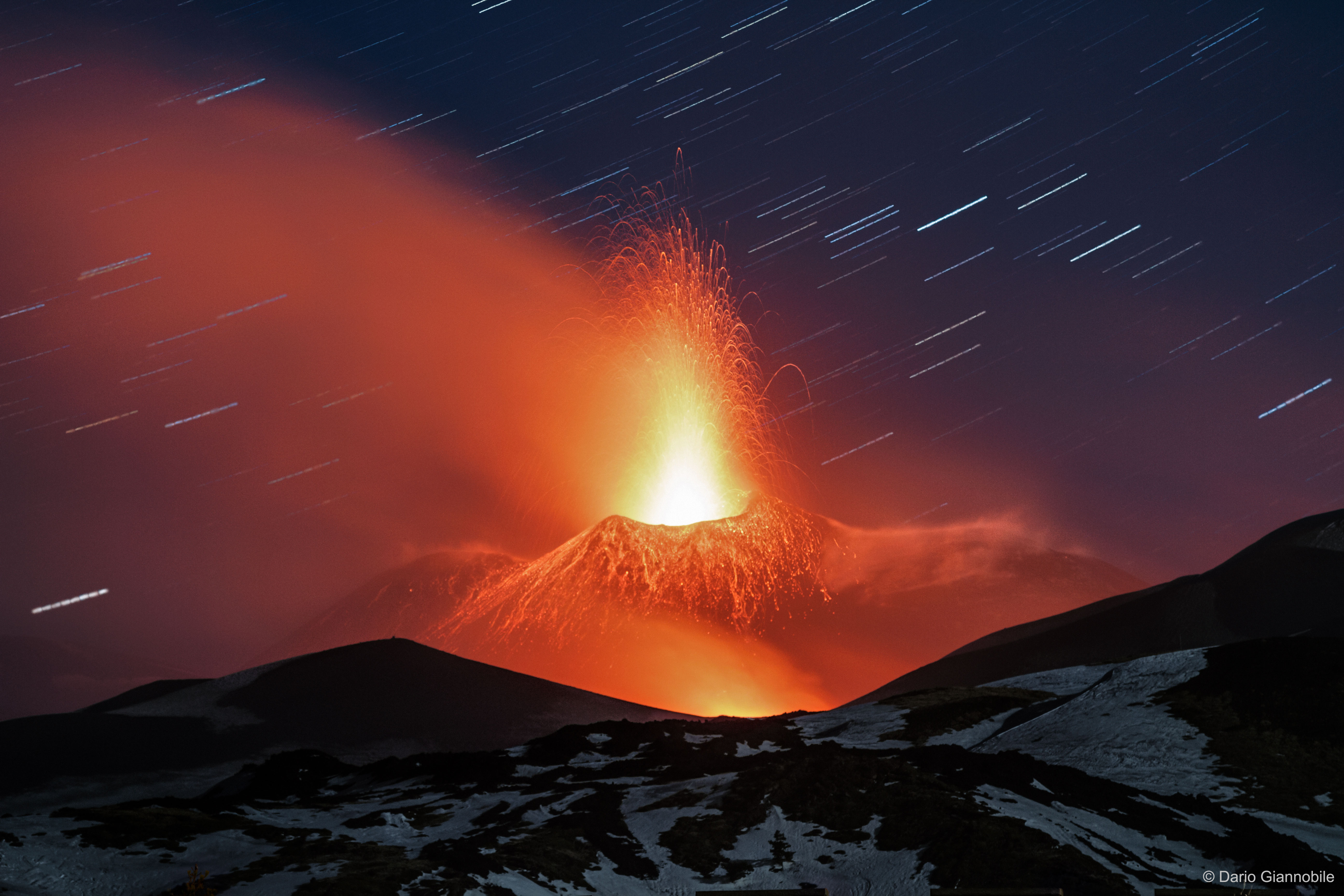
Mt. Etna Lava Plume
Image Credit & Copyright: Dario Giannobile
Explanation: Mt. Etna has been erupting for hundreds of thousands of years. Located in Sicily, Italy, the volcano produces lava fountains over one kilometer high. Mt. Etna is not only one of the most active volcanoes on Earth, it is one of the largest, measuring over 50 kilometers at its base and rising nearly 3 kilometers high. Pictured in mid-March, a spectacular lava plume erupts upwards, dangerous molten volcanic bombs fly off to the sides, while hot lava flows down the volcano's exterior. The Earth's rotation is discernable on this carefully time, moon-lit, long duration image as star trails.

Mt. Etna Lava Plume
Image Credit & Copyright: Dario Giannobile
Explanation: Mt. Etna has been erupting for hundreds of thousands of years. Located in Sicily, Italy, the volcano produces lava fountains over one kilometer high. Mt. Etna is not only one of the most active volcanoes on Earth, it is one of the largest, measuring over 50 kilometers at its base and rising nearly 3 kilometers high. Pictured in mid-March, a spectacular lava plume erupts upwards, dangerous molten volcanic bombs fly off to the sides, while hot lava flows down the volcano's exterior. The Earth's rotation is discernable on this carefully time, moon-lit, long duration image as star trails.

panosol- Αριθμός μηνυμάτων : 762
Points : 927
Reputation : 15
Ημερομηνία εγγραφής : 17/06/2012
Ηλικία : 56
 2017 April 27
2017 April 27
2017 April 27

Lyrids in Southern Skies
Image Credit & Copyright: Yuri Beletsky (Carnegie Las Campanas Observatory, TWAN)
Explanation: Earth's annual Lyrid meteor shower peaked before dawn on April 22nd, as our fair planet plowed through dust from the tail of long-period comet Thatcher. Seen from the high, dark, and dry Atacama desert a waning crescent Moon and brilliant Venus join Lyrid meteor streaks in this composited view. Captured over 5 hours on the night of April 21/22, the meteors stream away from the shower's radiant, a point not very far on the sky from Vega, alpha star of the constellation Lyra. The radiant effect is due to perspective as the parallel meteor tracks appear to converge in the distance. In the foreground are domes of the Las Campanas Observatory housing (left to right) the 2.5 meter du Pont Telescope and the 1.3 meter Optical Gravitational Lensing Experiment (OGLE) telescope.

Lyrids in Southern Skies
Image Credit & Copyright: Yuri Beletsky (Carnegie Las Campanas Observatory, TWAN)
Explanation: Earth's annual Lyrid meteor shower peaked before dawn on April 22nd, as our fair planet plowed through dust from the tail of long-period comet Thatcher. Seen from the high, dark, and dry Atacama desert a waning crescent Moon and brilliant Venus join Lyrid meteor streaks in this composited view. Captured over 5 hours on the night of April 21/22, the meteors stream away from the shower's radiant, a point not very far on the sky from Vega, alpha star of the constellation Lyra. The radiant effect is due to perspective as the parallel meteor tracks appear to converge in the distance. In the foreground are domes of the Las Campanas Observatory housing (left to right) the 2.5 meter du Pont Telescope and the 1.3 meter Optical Gravitational Lensing Experiment (OGLE) telescope.

panosol- Αριθμός μηνυμάτων : 762
Points : 927
Reputation : 15
Ημερομηνία εγγραφής : 17/06/2012
Ηλικία : 56
 2017 April 28
2017 April 28
2017 April 28
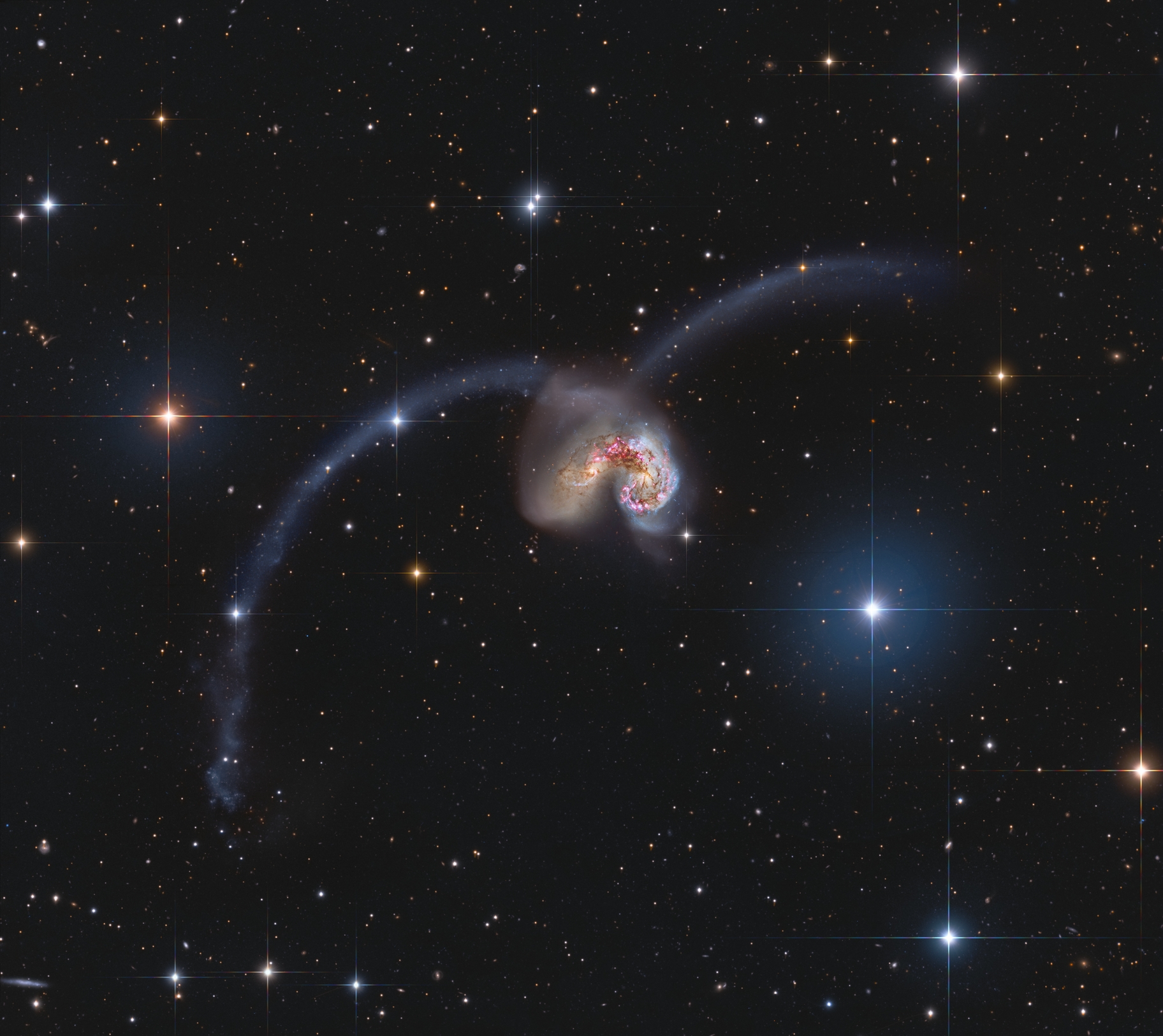
Exploring the Antennae
Image Credit & Copyright: Data; Subaru, NAOJ, NASA/ESA/Hubble - Assembly and Processing; Roberto Colombari
Explanation: Some 60 million light-years away in the southerly constellation Corvus, two large galaxies are colliding. Stars in the two galaxies, cataloged as NGC 4038 and NGC 4039, very rarely collide in the course of the ponderous cataclysm that lasts for hundreds of millions of years. But the galaxies' large clouds of molecular gas and dust often do, triggering furious episodes of star formation near the center of the cosmic wreckage. Spanning over 500 thousand light-years, this stunning view also reveals new star clusters and matter flung far from the scene of the accident by gravitational tidal forces. The remarkable mosaicked image was constructed using data from the ground-based Subaru telescope to bring out large-scale and faint tidal streams, and Hubble Space Telescope data of extreme detail in the bright cores. The suggestive visual appearance of the extended arcing structures gives the galaxy pair its popular name - The Antennae.

Exploring the Antennae
Image Credit & Copyright: Data; Subaru, NAOJ, NASA/ESA/Hubble - Assembly and Processing; Roberto Colombari
Explanation: Some 60 million light-years away in the southerly constellation Corvus, two large galaxies are colliding. Stars in the two galaxies, cataloged as NGC 4038 and NGC 4039, very rarely collide in the course of the ponderous cataclysm that lasts for hundreds of millions of years. But the galaxies' large clouds of molecular gas and dust often do, triggering furious episodes of star formation near the center of the cosmic wreckage. Spanning over 500 thousand light-years, this stunning view also reveals new star clusters and matter flung far from the scene of the accident by gravitational tidal forces. The remarkable mosaicked image was constructed using data from the ground-based Subaru telescope to bring out large-scale and faint tidal streams, and Hubble Space Telescope data of extreme detail in the bright cores. The suggestive visual appearance of the extended arcing structures gives the galaxy pair its popular name - The Antennae.

panosol- Αριθμός μηνυμάτων : 762
Points : 927
Reputation : 15
Ημερομηνία εγγραφής : 17/06/2012
Ηλικία : 56
 2017 April 29
2017 April 29
2017 April 29
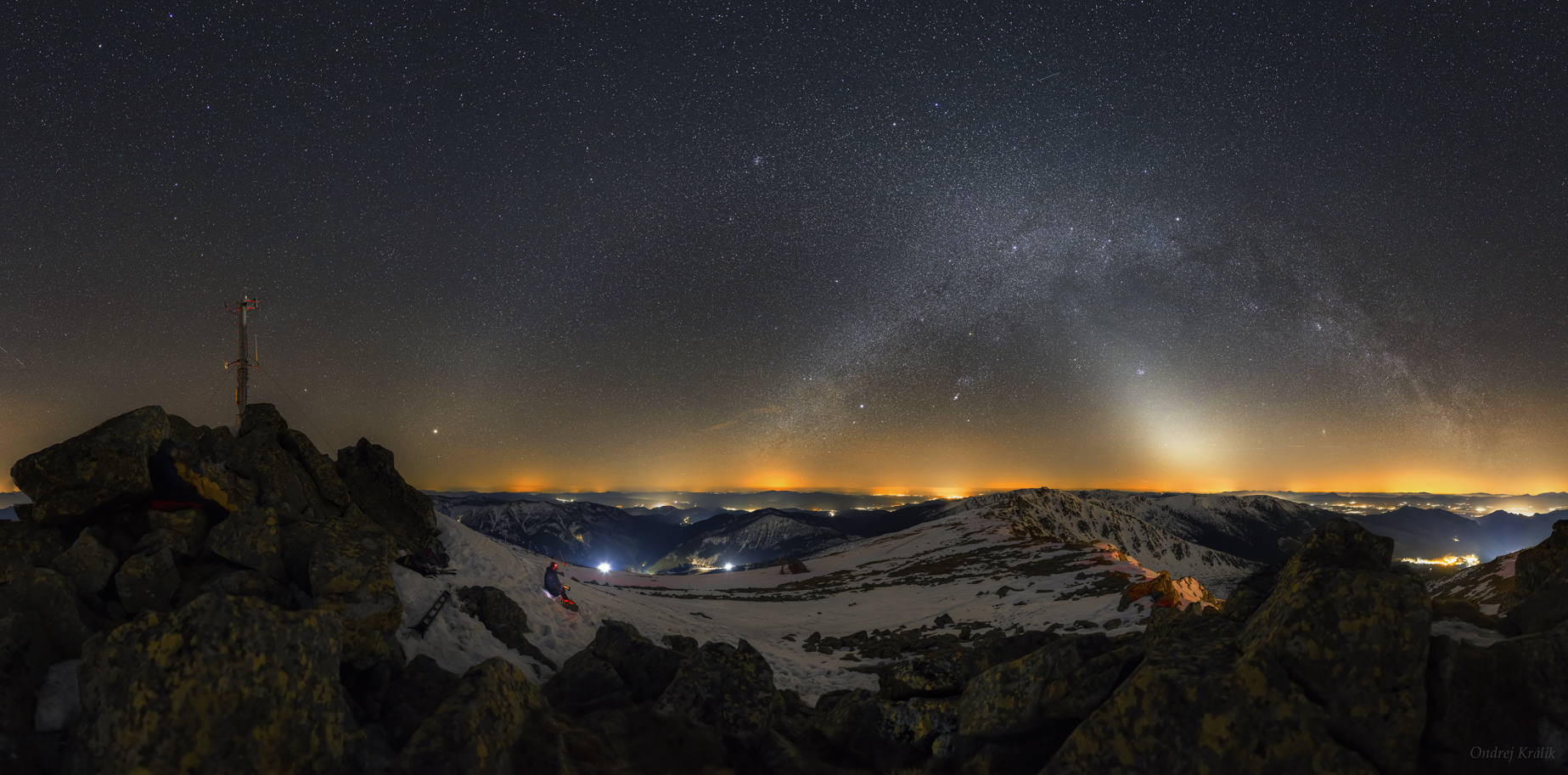
Arches of Spring
Image Credit & Copyright: Ondrej Kralik
Explanation: Two luminous arches stretched across the dome of the sky on this northern spring night. After sunset on March 29, the mountain view panorama was captured in 57 exposures from Chopok peak in central Slovakia at an altitude of about 2,000 meters. The arc of the northern Milky Way is visible toward the right, but only after it reaches above the terrestrial lights from the mountain top perspective. Though dusk has passed, a bright patch of celestial light still hovers near the horizon and fades into a second luminous arch of Zodiacal Light, crossing near the center of the Milky Way. Dust in the ecliptic plane reflects sunlight to create the Zodiacal glow, typically prominent after sunset in clear, dark, skies of the northern spring. Almost opposite the Sun, Jupiter shines brightly near the horizon toward the left. Since Jupiter lies near the ecliptic, it appears within the slight brightening of the Zodiacal band also opposite the Sun called the Gegenschein.

Arches of Spring
Image Credit & Copyright: Ondrej Kralik
Explanation: Two luminous arches stretched across the dome of the sky on this northern spring night. After sunset on March 29, the mountain view panorama was captured in 57 exposures from Chopok peak in central Slovakia at an altitude of about 2,000 meters. The arc of the northern Milky Way is visible toward the right, but only after it reaches above the terrestrial lights from the mountain top perspective. Though dusk has passed, a bright patch of celestial light still hovers near the horizon and fades into a second luminous arch of Zodiacal Light, crossing near the center of the Milky Way. Dust in the ecliptic plane reflects sunlight to create the Zodiacal glow, typically prominent after sunset in clear, dark, skies of the northern spring. Almost opposite the Sun, Jupiter shines brightly near the horizon toward the left. Since Jupiter lies near the ecliptic, it appears within the slight brightening of the Zodiacal band also opposite the Sun called the Gegenschein.

panosol- Αριθμός μηνυμάτων : 762
Points : 927
Reputation : 15
Ημερομηνία εγγραφής : 17/06/2012
Ηλικία : 56
 2017 April 30
2017 April 30
2017 April 30
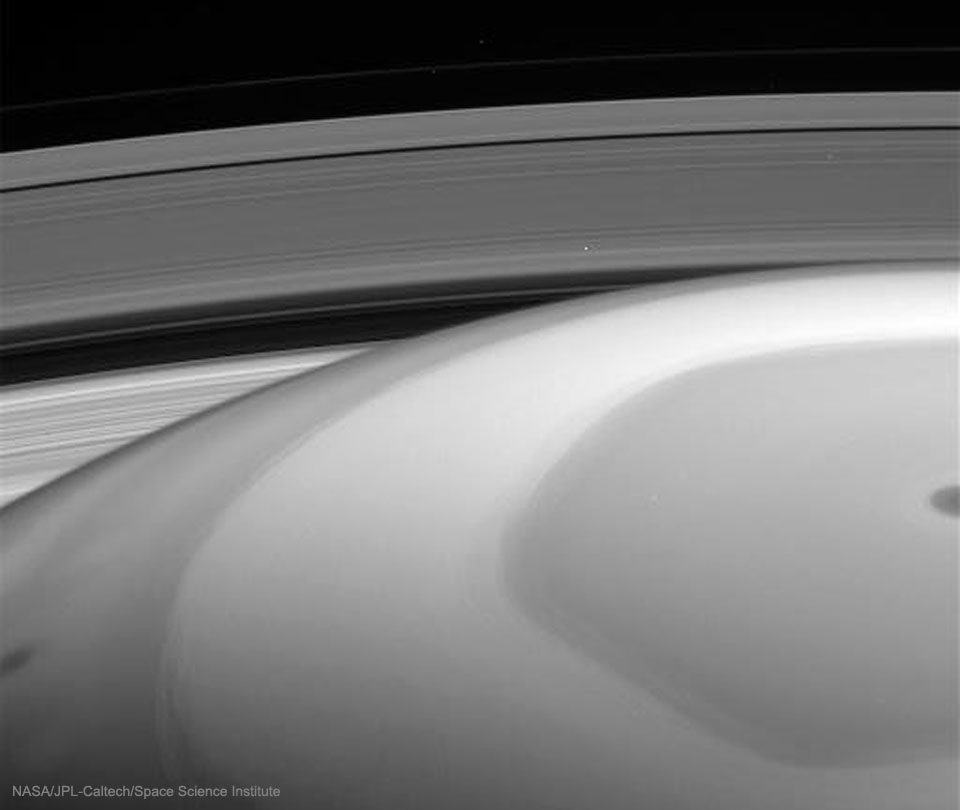
Cassini Looks Out from Saturn
Image Credit: NASA, JPL-Caltech, Space Science Institute
Explanation: This is what Saturn looks like from inside the rings. Last week, for the first time, NASA directed the Cassini spacecraft to swoop between Saturn and its rings. During the dive, the robotic spacecraft took hundreds of images showing unprecedented detail for structures in Saturn's atmosphere. Looking back out, however, the spacecraft was also able to capture impressive vistas. In the featured image taken a few hours before closest approach, Saturn's unusual northern hexagon is seen surrounding the North Pole. Saturn's C ring is the closest visible, while the dark Cassini Division separates the inner B ring from the outer A. A close inspection will find the two small moons that shepherd the F-ring, the farthest ring discernable. This image is raw and will be officially verified, calibrated and released at a later date. Cassini remains on schedule to end its mission by plunging into Saturn's atmosphere on September 15.

Cassini Looks Out from Saturn
Image Credit: NASA, JPL-Caltech, Space Science Institute
Explanation: This is what Saturn looks like from inside the rings. Last week, for the first time, NASA directed the Cassini spacecraft to swoop between Saturn and its rings. During the dive, the robotic spacecraft took hundreds of images showing unprecedented detail for structures in Saturn's atmosphere. Looking back out, however, the spacecraft was also able to capture impressive vistas. In the featured image taken a few hours before closest approach, Saturn's unusual northern hexagon is seen surrounding the North Pole. Saturn's C ring is the closest visible, while the dark Cassini Division separates the inner B ring from the outer A. A close inspection will find the two small moons that shepherd the F-ring, the farthest ring discernable. This image is raw and will be officially verified, calibrated and released at a later date. Cassini remains on schedule to end its mission by plunging into Saturn's atmosphere on September 15.

panosol- Αριθμός μηνυμάτων : 762
Points : 927
Reputation : 15
Ημερομηνία εγγραφής : 17/06/2012
Ηλικία : 56
 2017 May 1
2017 May 1
2017 May 1

Cooling Neutron Star
Image Credit: X-ray: NASA/CXC/UNAM/Ioffe/D.Page, P. Shternin et al; Optical: NASA/STScI;
Illustration: NASA/CXC/M. Weiss
Explanation: The bright source near the center is a neutron star, the incredibly dense, collapsed remains of a massive stellar core. Surrounding it is supernova remnant Cassiopeia A (Cas A), a comfortable 11,000 light-years away. Light from the Cas A supernova, the death explosion of a massive star, first reached Earth about 350 years ago. The expanding debris cloud spans about 15 light-years in this composite X-ray/optical image. Still hot enough to emit X-rays, Cas A's neutron star is cooling. In fact, years of observations with the orbiting Chandra X-ray Observatory find that the neutron star is cooling rapidly -- so rapidly that researchers suspect a large part of the neutron star's core is forming a frictionless neutron superfluid. The Chandra results represent the first observational evidence for this bizarre state of neutron matter.

Cooling Neutron Star
Image Credit: X-ray: NASA/CXC/UNAM/Ioffe/D.Page, P. Shternin et al; Optical: NASA/STScI;
Illustration: NASA/CXC/M. Weiss
Explanation: The bright source near the center is a neutron star, the incredibly dense, collapsed remains of a massive stellar core. Surrounding it is supernova remnant Cassiopeia A (Cas A), a comfortable 11,000 light-years away. Light from the Cas A supernova, the death explosion of a massive star, first reached Earth about 350 years ago. The expanding debris cloud spans about 15 light-years in this composite X-ray/optical image. Still hot enough to emit X-rays, Cas A's neutron star is cooling. In fact, years of observations with the orbiting Chandra X-ray Observatory find that the neutron star is cooling rapidly -- so rapidly that researchers suspect a large part of the neutron star's core is forming a frictionless neutron superfluid. The Chandra results represent the first observational evidence for this bizarre state of neutron matter.

panosol- Αριθμός μηνυμάτων : 762
Points : 927
Reputation : 15
Ημερομηνία εγγραφής : 17/06/2012
Ηλικία : 56
 2017 May 2
2017 May 2
2017 May 2
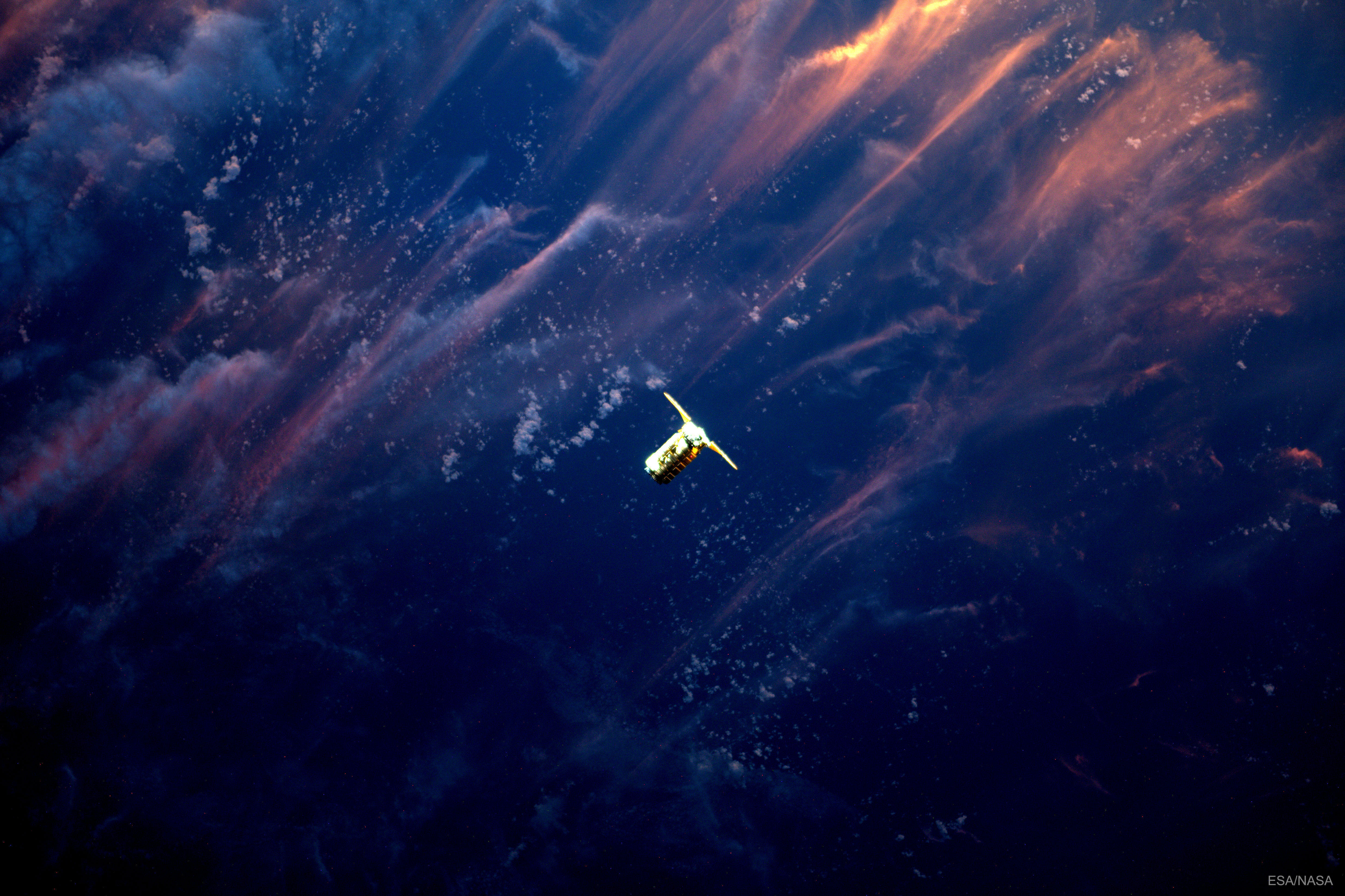
Approach above Sunset
Image Credit: ESA, NASA
Explanation: There it is! The Cygnus supply ship was a welcome sight to the astronauts on the International Space Station just over a week ago. Launched three days before on a United Launch Alliance Atlas V from Cape Canaveral, Florida, the Orbital ATK's Cygnus spacecraft approached the International Space Station above the backdrop of a picturesque planet Earth. The Sun was setting off the image to the upper left, illuminating clouds well below the approaching vehicle. The robotic Cygnus spacecraft was captured first on camera and later with the space station's Canadarm2 by ESA's Flight Engineer Thomas Pesquet and NASA's Expedition-51 Commander Peggy Whitson. Commander Whitson, a biochemist, has now set a new American record for the most total days in space. Besides essentials, the Cygnus carried equipment to bolster over 200 science experiments being conducted on the football-field sized Earth-orbiting outpost.

Approach above Sunset
Image Credit: ESA, NASA
Explanation: There it is! The Cygnus supply ship was a welcome sight to the astronauts on the International Space Station just over a week ago. Launched three days before on a United Launch Alliance Atlas V from Cape Canaveral, Florida, the Orbital ATK's Cygnus spacecraft approached the International Space Station above the backdrop of a picturesque planet Earth. The Sun was setting off the image to the upper left, illuminating clouds well below the approaching vehicle. The robotic Cygnus spacecraft was captured first on camera and later with the space station's Canadarm2 by ESA's Flight Engineer Thomas Pesquet and NASA's Expedition-51 Commander Peggy Whitson. Commander Whitson, a biochemist, has now set a new American record for the most total days in space. Besides essentials, the Cygnus carried equipment to bolster over 200 science experiments being conducted on the football-field sized Earth-orbiting outpost.

panosol- Αριθμός μηνυμάτων : 762
Points : 927
Reputation : 15
Ημερομηνία εγγραφής : 17/06/2012
Ηλικία : 56
 2017 May 3
2017 May 3
2017 May 3

NGC 3628: The Hamburger Galaxy
Image Credit & Copyright: Eric Coles and Mel Helm
Explanation: No, hamburgers are not this big. What is pictured is a sharp telescopic views of a magnificent edge-on spiral galaxy NGC 3628, a puffy galactic disk divided by dark dust lanes. Of course, this deep galactic portrait puts some astronomers in mind of its popular moniker, The Hamburger Galaxy. The tantalizing island universe is about 100,000 light-years across and 35 million light-years away in the northern springtime constellation Leo. NGC 3628 shares its neighborhood in the local Universe with two other large spirals M65 and M66 in a grouping otherwise known as the Leo Triplet. Gravitational interactions with its cosmic neighbors are likely responsible for the extended flare and warp of this spiral's disk.

NGC 3628: The Hamburger Galaxy
Image Credit & Copyright: Eric Coles and Mel Helm
Explanation: No, hamburgers are not this big. What is pictured is a sharp telescopic views of a magnificent edge-on spiral galaxy NGC 3628, a puffy galactic disk divided by dark dust lanes. Of course, this deep galactic portrait puts some astronomers in mind of its popular moniker, The Hamburger Galaxy. The tantalizing island universe is about 100,000 light-years across and 35 million light-years away in the northern springtime constellation Leo. NGC 3628 shares its neighborhood in the local Universe with two other large spirals M65 and M66 in a grouping otherwise known as the Leo Triplet. Gravitational interactions with its cosmic neighbors are likely responsible for the extended flare and warp of this spiral's disk.

panosol- Αριθμός μηνυμάτων : 762
Points : 927
Reputation : 15
Ημερομηνία εγγραφής : 17/06/2012
Ηλικία : 56
 2017 May 4
2017 May 4
2017 May 4
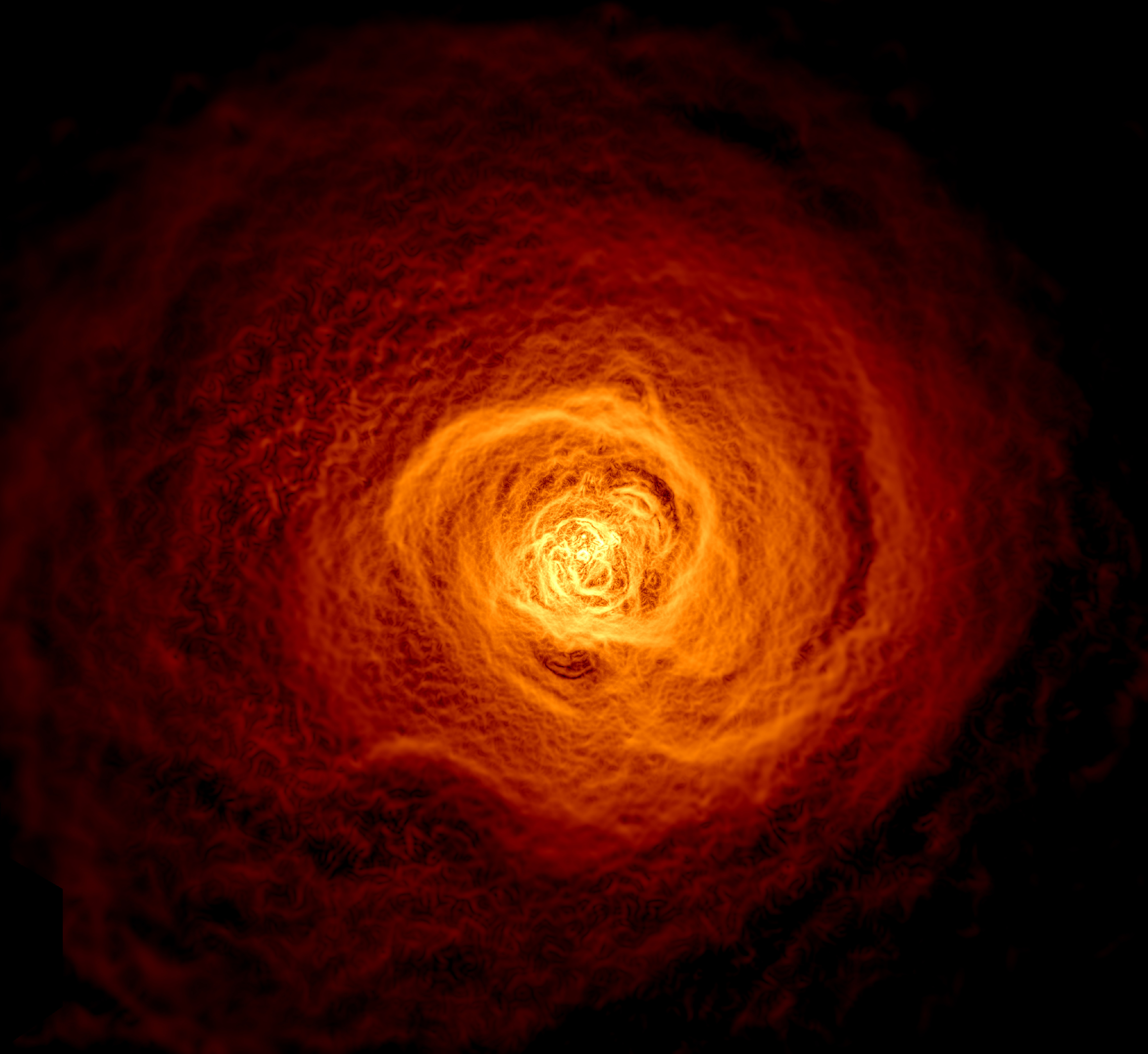
The Perseus Cluster Waves
Image Credit: NASA, CXC, GSFC, Stephen Walker, et al.
Explanation: The cosmic swirl and slosh of giant waves in an enormous reservoir of glowing hot gas are traced in this enhanced X-ray image from the Chandra Observatory. The frame spans over 1 million light-years across the center of the nearby Perseus Galaxy Cluster, some 240 million light-years distant. Like other clusters of galaxies, most of the observable mass in the Perseus cluster is in the form of the cluster-filling gas. With temperatures in the tens of millions of degrees, the gas glows brightly in X-rays. Computer simulations can reproduce details of the structures sloshing through the Perseus cluster's X-ray hot gas, including the remarkable concave bay seen below and left of center. About 200,000 light-years across, twice the size of the Milky Way, the bay's formation indicates that Perseus itself was likely grazed by a smaller galaxy cluster billions of years ago.

The Perseus Cluster Waves
Image Credit: NASA, CXC, GSFC, Stephen Walker, et al.
Explanation: The cosmic swirl and slosh of giant waves in an enormous reservoir of glowing hot gas are traced in this enhanced X-ray image from the Chandra Observatory. The frame spans over 1 million light-years across the center of the nearby Perseus Galaxy Cluster, some 240 million light-years distant. Like other clusters of galaxies, most of the observable mass in the Perseus cluster is in the form of the cluster-filling gas. With temperatures in the tens of millions of degrees, the gas glows brightly in X-rays. Computer simulations can reproduce details of the structures sloshing through the Perseus cluster's X-ray hot gas, including the remarkable concave bay seen below and left of center. About 200,000 light-years across, twice the size of the Milky Way, the bay's formation indicates that Perseus itself was likely grazed by a smaller galaxy cluster billions of years ago.

panosol- Αριθμός μηνυμάτων : 762
Points : 927
Reputation : 15
Ημερομηνία εγγραφής : 17/06/2012
Ηλικία : 56
 2017 May 5
2017 May 5
2017 May 5
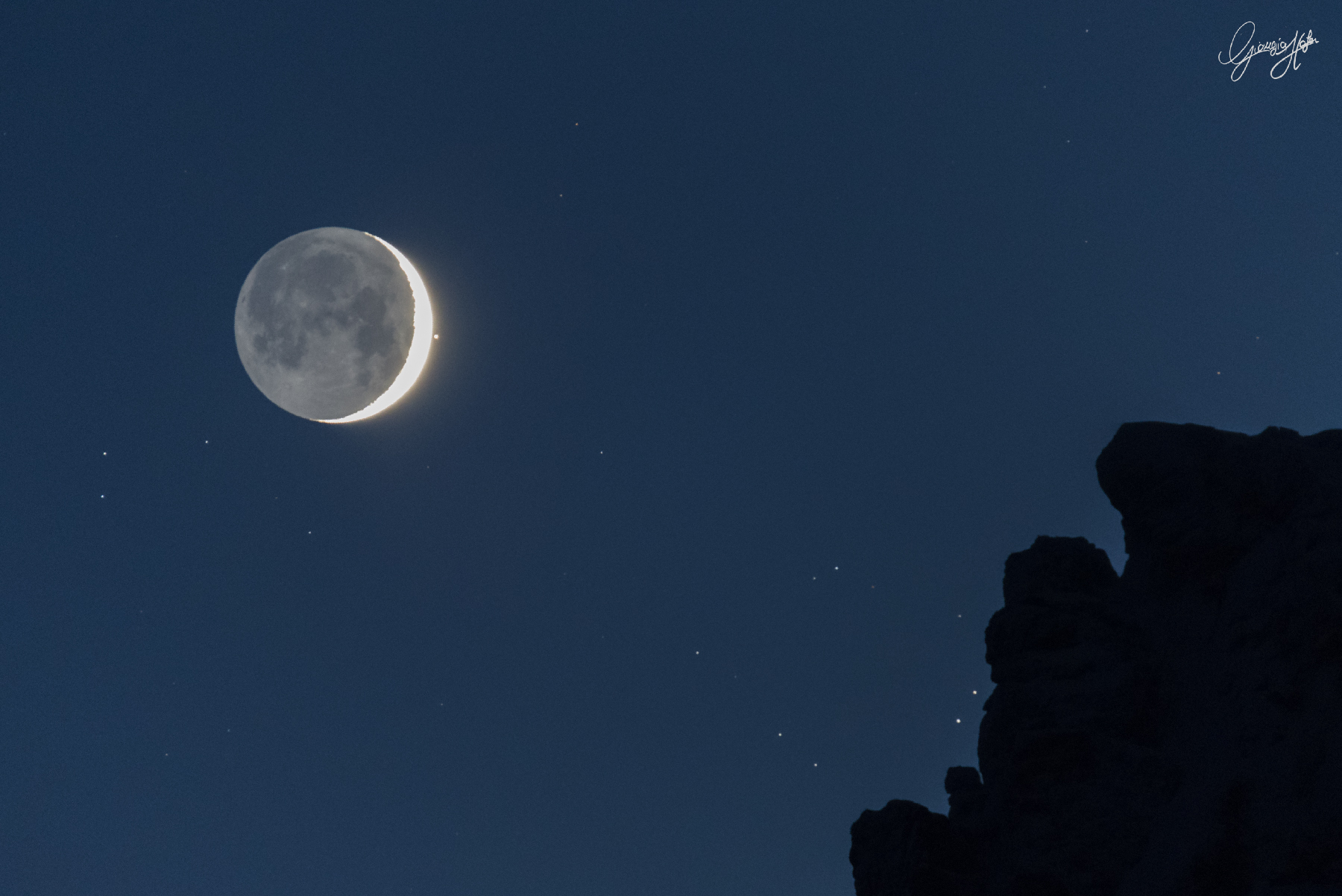
The Bull's Eye and the Young Moon
Image Credit & Copyright: Giorgia Hofer
Explanation: Aldebaran, eye of Taurus the Bull, and a young crescent Moon shared an early evening sky last Friday. The lovely celestial pairing could be enjoyed around planet Earth, but from some locations the Moon was even seen to pass in front of Aldebaran, a dramatic lunar occultation of the familiar bright star. Taken at nightfall on April 28, this skyscape captures Aldebaran shortly after it emerged from behind the bright lunar limb. In the foreground are craggy peaks of the Dolomite mountains near Laggio di Cadore, Italy. Before reappearing beyond the sunlit crescent, Aldebaran first winked out behind the Moon's ashen glow, the lunar nightside faintly illuminated by earthshine.

The Bull's Eye and the Young Moon
Image Credit & Copyright: Giorgia Hofer
Explanation: Aldebaran, eye of Taurus the Bull, and a young crescent Moon shared an early evening sky last Friday. The lovely celestial pairing could be enjoyed around planet Earth, but from some locations the Moon was even seen to pass in front of Aldebaran, a dramatic lunar occultation of the familiar bright star. Taken at nightfall on April 28, this skyscape captures Aldebaran shortly after it emerged from behind the bright lunar limb. In the foreground are craggy peaks of the Dolomite mountains near Laggio di Cadore, Italy. Before reappearing beyond the sunlit crescent, Aldebaran first winked out behind the Moon's ashen glow, the lunar nightside faintly illuminated by earthshine.

panosol- Αριθμός μηνυμάτων : 762
Points : 927
Reputation : 15
Ημερομηνία εγγραφής : 17/06/2012
Ηλικία : 56
 2017 May 6
2017 May 6
2017 May 6
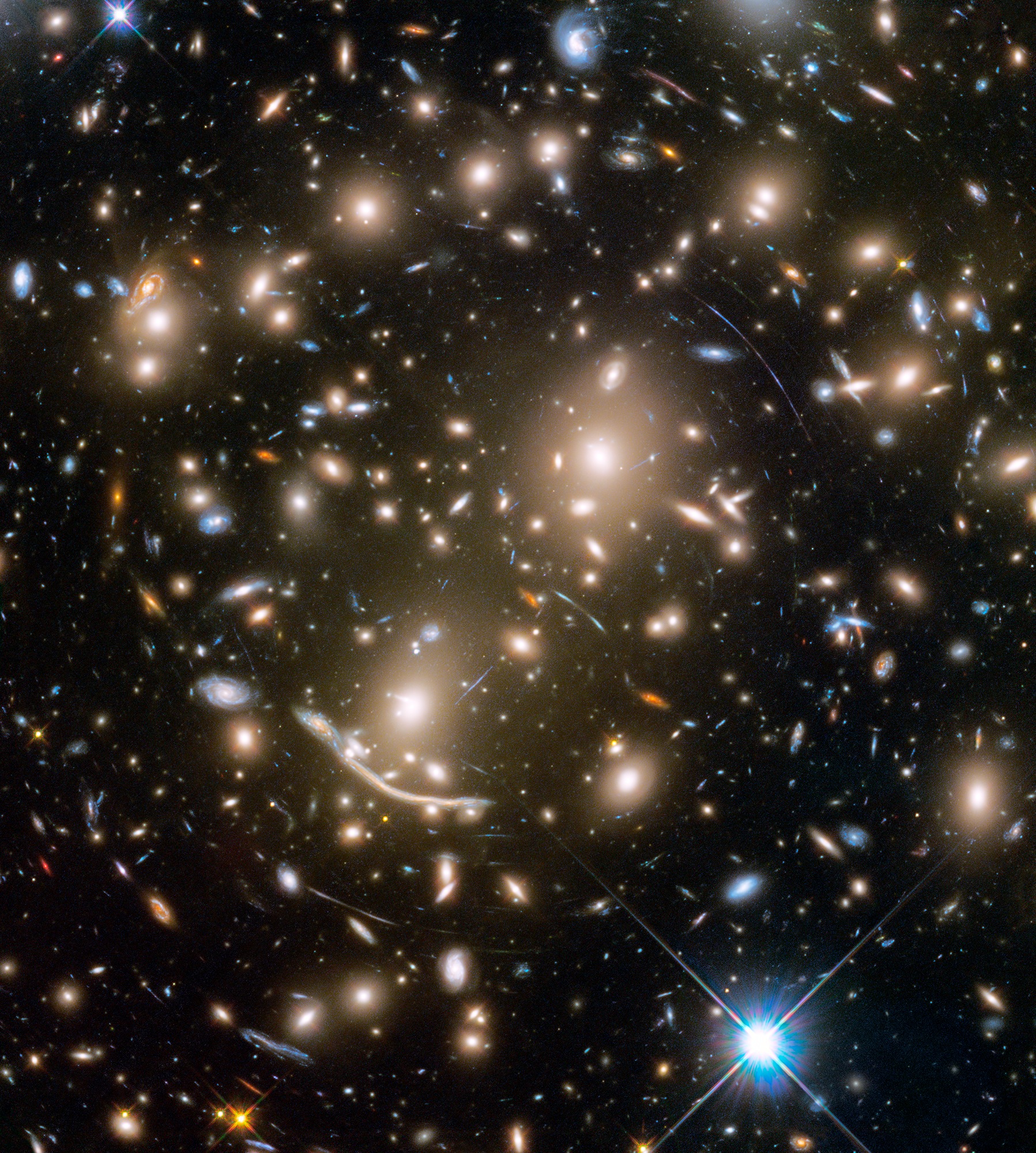
Galaxy Cluster Abell 370 and Beyond
Image Credit: NASA, ESA, Jennifer Lotz and the HFF Team (STScI)
Explanation: Some 4 billion light-years away, massive galaxy cluster Abell 370 only appears to be dominated by two giant elliptical galaxies and infested with faint arcs in this sharp Hubble Space Telescope snapshot. The fainter, scattered bluish arcs along with the dramatic dragon arc below and left of center are images of galaxies that lie far beyond Abell 370. About twice as distant, their otherwise undetected light is magnified and distorted by the cluster's enormous gravitational mass, dominated by unseen dark matter. Providing a tantalizing glimpse of galaxies in the early universe, the effect is known as gravitational lensing. A consequence of warped spacetime it was first predicted by Einstein a century ago. Far beyond the spiky foreground Milky Way star at lower right, Abell 370 is seen toward the constellation Cetus, the Sea Monster. It is the last of six galaxy clusters imaged in the recently concluded Frontier Fields project.

Galaxy Cluster Abell 370 and Beyond
Image Credit: NASA, ESA, Jennifer Lotz and the HFF Team (STScI)
Explanation: Some 4 billion light-years away, massive galaxy cluster Abell 370 only appears to be dominated by two giant elliptical galaxies and infested with faint arcs in this sharp Hubble Space Telescope snapshot. The fainter, scattered bluish arcs along with the dramatic dragon arc below and left of center are images of galaxies that lie far beyond Abell 370. About twice as distant, their otherwise undetected light is magnified and distorted by the cluster's enormous gravitational mass, dominated by unseen dark matter. Providing a tantalizing glimpse of galaxies in the early universe, the effect is known as gravitational lensing. A consequence of warped spacetime it was first predicted by Einstein a century ago. Far beyond the spiky foreground Milky Way star at lower right, Abell 370 is seen toward the constellation Cetus, the Sea Monster. It is the last of six galaxy clusters imaged in the recently concluded Frontier Fields project.

panosol- Αριθμός μηνυμάτων : 762
Points : 927
Reputation : 15
Ημερομηνία εγγραφής : 17/06/2012
Ηλικία : 56
 2017 May 7
2017 May 7
2017 May 7
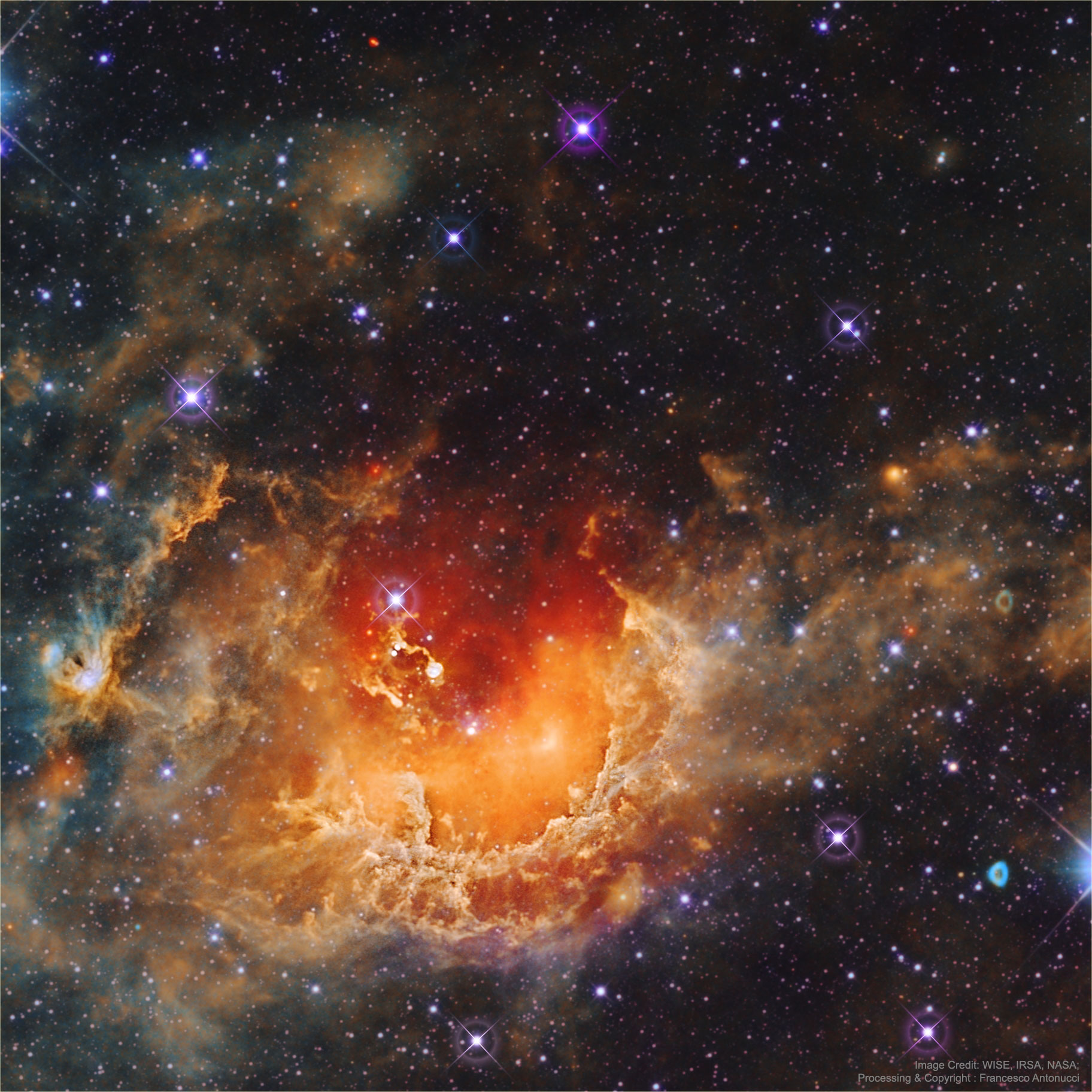
Star Formation in the Tadpole Nebula
Image Credit: WISE, IRSA, NASA; Processing & Copyright: Francesco Antonucci
Explanation: What's all of the commotion in the Tadpole nebula? Star formation. Dusty emission in the Tadpole nebula, IC 410, lies about 12,000 light-years away in the northern constellation of the Charioteer (Auriga). The cloud of glowing gas is over 100 light-years across, sculpted by stellar winds and radiation from embedded open star cluster NGC 1893. Formed in the interstellar cloud a mere 4 million years ago, bright newly formed cluster stars are seen all around the star-forming nebula. Notable near the image center are two relatively dense streamers of material trailing away from the nebula's central regions. Potentially sites of ongoing star formation in IC 410, these cosmic tadpole shapes are about 10 light-years long. The featured image was taken in infrared light by NASA's Wide Field Infrared Survey Explorer (WISE) satellite.

Star Formation in the Tadpole Nebula
Image Credit: WISE, IRSA, NASA; Processing & Copyright: Francesco Antonucci
Explanation: What's all of the commotion in the Tadpole nebula? Star formation. Dusty emission in the Tadpole nebula, IC 410, lies about 12,000 light-years away in the northern constellation of the Charioteer (Auriga). The cloud of glowing gas is over 100 light-years across, sculpted by stellar winds and radiation from embedded open star cluster NGC 1893. Formed in the interstellar cloud a mere 4 million years ago, bright newly formed cluster stars are seen all around the star-forming nebula. Notable near the image center are two relatively dense streamers of material trailing away from the nebula's central regions. Potentially sites of ongoing star formation in IC 410, these cosmic tadpole shapes are about 10 light-years long. The featured image was taken in infrared light by NASA's Wide Field Infrared Survey Explorer (WISE) satellite.

panosol- Αριθμός μηνυμάτων : 762
Points : 927
Reputation : 15
Ημερομηνία εγγραφής : 17/06/2012
Ηλικία : 56
 2017 May 8
2017 May 8
2017 May 8

(click on image for full resolution viewing: 8776X2000)
Ancient Ogunquit Beach on Mars
Image Credit: NASA, JPL-Caltech, MSSS;
Explanation: This was once a beach -- on ancient Mars. The featured 360-degree panorama, horizontally compressed, was taken by the robotic Curiosity rover currently exploring the red planet. Named Ogunquit Beach after its terrestrial counterpart, evidence shows that at times long ago the area was underwater, while at other times it was at the edge of an ancient lake. The light peak in the central background is the top of Mount Sharp, the central feature in Gale Crater where Curiosity has been deployed. Curiosity is slowly ascending Mount Sharp. Portions of the dark sands in the foreground have been scooped up for analysis. The light colored bedrock is composed of sediment that likely settled at the bottom of the now-dried lakebed. The featured panorama (interactive version here) was created from over 100 images acquired in late March and seemingly signed by the rover on the lower left. Currently, Curiosity is carefully crossing deep megaripples of dark sands on its way to explore Vera Rubin Ridge.

(click on image for full resolution viewing: 8776X2000)
Ancient Ogunquit Beach on Mars
Image Credit: NASA, JPL-Caltech, MSSS;
Explanation: This was once a beach -- on ancient Mars. The featured 360-degree panorama, horizontally compressed, was taken by the robotic Curiosity rover currently exploring the red planet. Named Ogunquit Beach after its terrestrial counterpart, evidence shows that at times long ago the area was underwater, while at other times it was at the edge of an ancient lake. The light peak in the central background is the top of Mount Sharp, the central feature in Gale Crater where Curiosity has been deployed. Curiosity is slowly ascending Mount Sharp. Portions of the dark sands in the foreground have been scooped up for analysis. The light colored bedrock is composed of sediment that likely settled at the bottom of the now-dried lakebed. The featured panorama (interactive version here) was created from over 100 images acquired in late March and seemingly signed by the rover on the lower left. Currently, Curiosity is carefully crossing deep megaripples of dark sands on its way to explore Vera Rubin Ridge.

panosol- Αριθμός μηνυμάτων : 762
Points : 927
Reputation : 15
Ημερομηνία εγγραφής : 17/06/2012
Ηλικία : 56
 2017 May 9
2017 May 9
2017 May 9
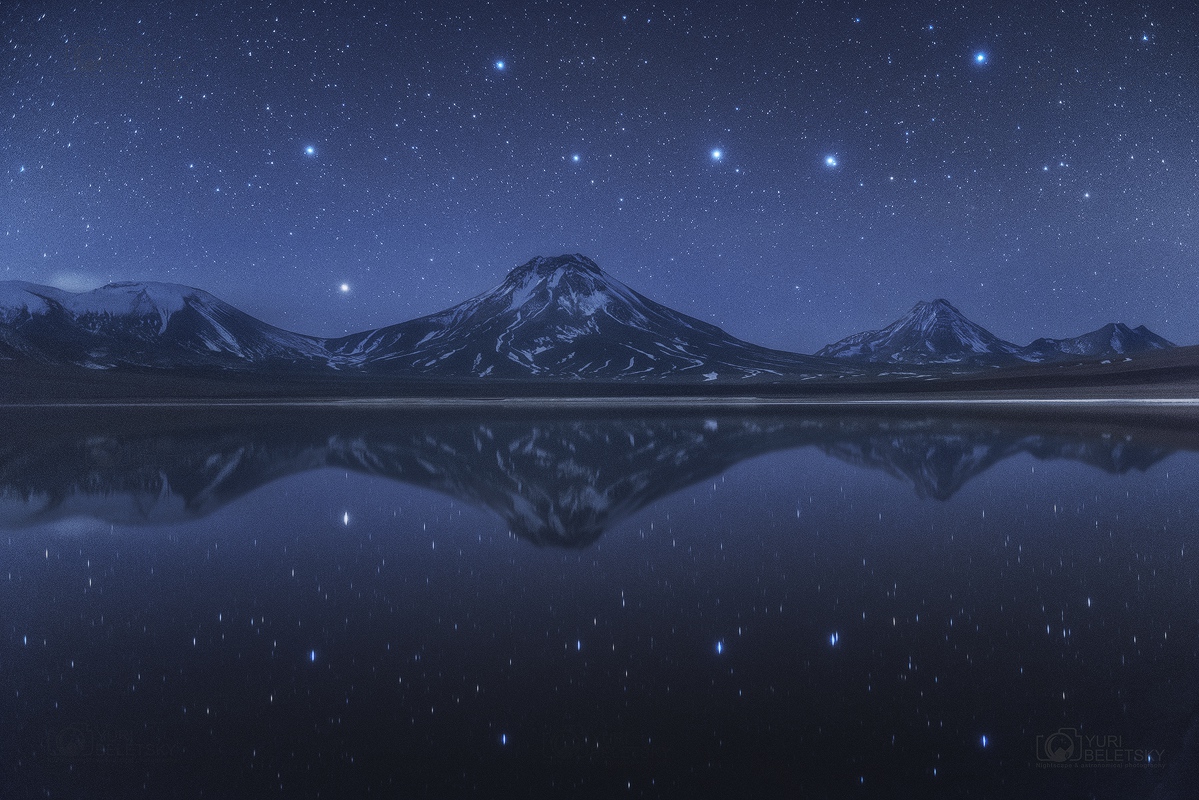
Big Dipper Above and Below Chilean Volcanoes
Image Credit & Copyright: Yuri Beletsky (Carnegie Las Campanas Observatory, TWAN)
Explanation: Do you see it? This common question frequently precedes the rediscovery of one of the most commonly recognized configurations of stars on the northern sky: the Big Dipper. This grouping of stars is one of the few things that has likely been seen, and will be seen, by every generation. The Big Dipper is not by itself a constellation. Although part of the constellation of the Great Bear (Ursa Major), the Big Dipper is an asterism that has been known by different names to different societies. Five of the Big Dipper stars are actually near each other in space and were likely formed at nearly the same time. Connecting two stars in the far part of the Big Dipper will lead one to Polaris, the North Star, which is part of the Little Dipper. Relative stellar motions will cause the Big Dipper to slowly change its configuration over the next 100,000 years. Pictured in late April, the Big Dipper was actually imaged twice -- above and below distant Chilean volcanoes, the later reflected from an unusually calm lagoon.

Big Dipper Above and Below Chilean Volcanoes
Image Credit & Copyright: Yuri Beletsky (Carnegie Las Campanas Observatory, TWAN)
Explanation: Do you see it? This common question frequently precedes the rediscovery of one of the most commonly recognized configurations of stars on the northern sky: the Big Dipper. This grouping of stars is one of the few things that has likely been seen, and will be seen, by every generation. The Big Dipper is not by itself a constellation. Although part of the constellation of the Great Bear (Ursa Major), the Big Dipper is an asterism that has been known by different names to different societies. Five of the Big Dipper stars are actually near each other in space and were likely formed at nearly the same time. Connecting two stars in the far part of the Big Dipper will lead one to Polaris, the North Star, which is part of the Little Dipper. Relative stellar motions will cause the Big Dipper to slowly change its configuration over the next 100,000 years. Pictured in late April, the Big Dipper was actually imaged twice -- above and below distant Chilean volcanoes, the later reflected from an unusually calm lagoon.

panosol- Αριθμός μηνυμάτων : 762
Points : 927
Reputation : 15
Ημερομηνία εγγραφής : 17/06/2012
Ηλικία : 56
 2017 May 10
2017 May 10
2017 May 10
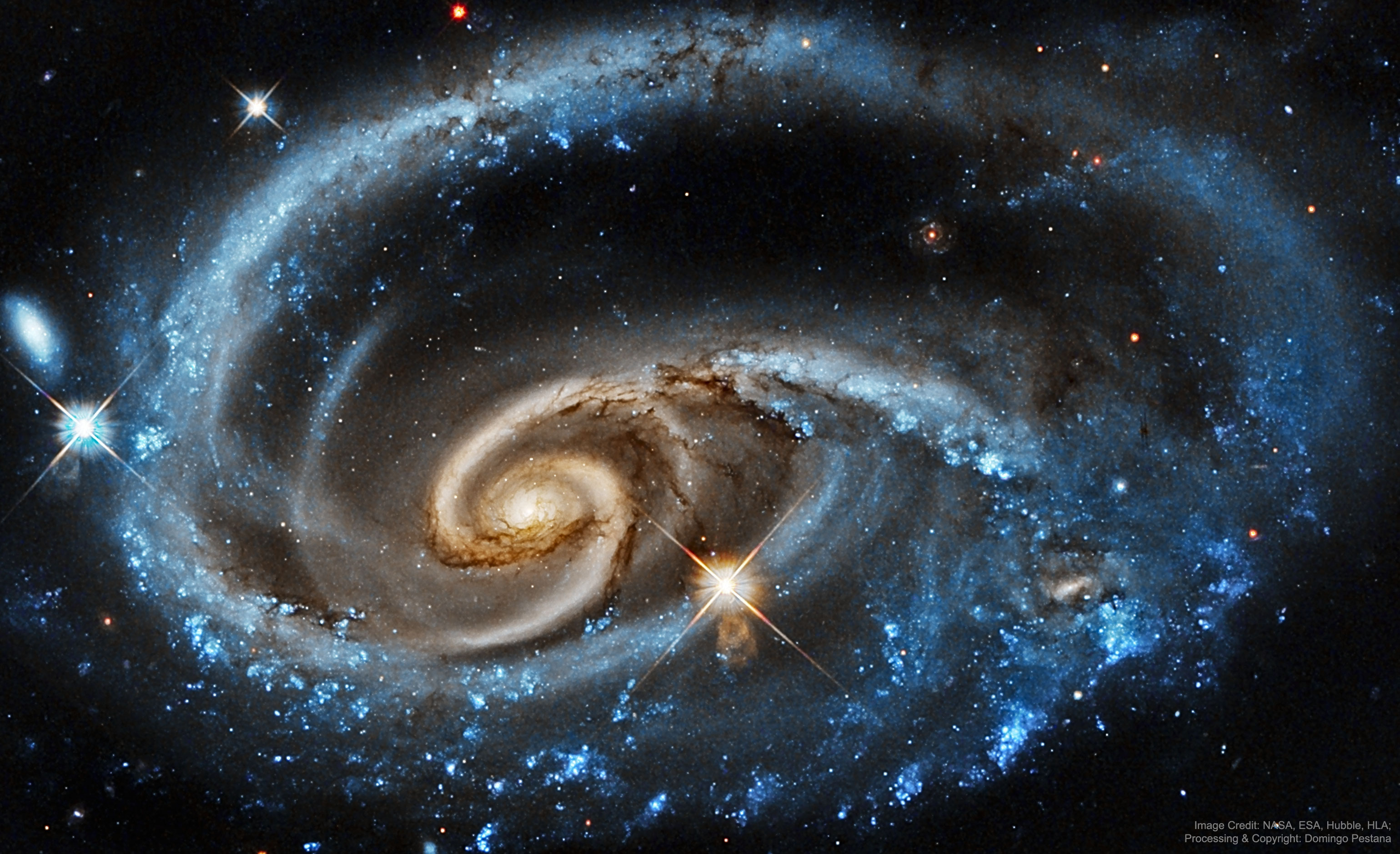
UGC 1810: Wildly Interacting Galaxy from Hubble
Image Credit: NASA, ESA, Hubble, HLA; Processing & Copyright: Domingo Pestana
Explanation: What's happening to this spiral galaxy? Although details remain uncertain, it surely has to do with an ongoing battle with its smaller galactic neighbor. The featured galaxy is labelled UGC 1810 by itself, but together with its collisional partner is known as Arp 273. The overall shape of the UGC 1810 -- in particular its blue outer ring -- is likely a result of wild and violent gravitational interactions. This ring's blue color is caused by massive stars that are blue hot and have formed only in the past few million years. The inner galaxy appears older, redder, and threaded with cool filamentary dust. A few bright stars appear well in the foreground, unrelated to UGC 1810, while several galaxies are visible well in the background. Arp 273 lies about 300 million light years away toward the constellation of Andromeda. Quite likely, UGC 1810 will devour its galactic sidekick over the next billion years and settle into a classic spiral form.

UGC 1810: Wildly Interacting Galaxy from Hubble
Image Credit: NASA, ESA, Hubble, HLA; Processing & Copyright: Domingo Pestana
Explanation: What's happening to this spiral galaxy? Although details remain uncertain, it surely has to do with an ongoing battle with its smaller galactic neighbor. The featured galaxy is labelled UGC 1810 by itself, but together with its collisional partner is known as Arp 273. The overall shape of the UGC 1810 -- in particular its blue outer ring -- is likely a result of wild and violent gravitational interactions. This ring's blue color is caused by massive stars that are blue hot and have formed only in the past few million years. The inner galaxy appears older, redder, and threaded with cool filamentary dust. A few bright stars appear well in the foreground, unrelated to UGC 1810, while several galaxies are visible well in the background. Arp 273 lies about 300 million light years away toward the constellation of Andromeda. Quite likely, UGC 1810 will devour its galactic sidekick over the next billion years and settle into a classic spiral form.

panosol- Αριθμός μηνυμάτων : 762
Points : 927
Reputation : 15
Ημερομηνία εγγραφής : 17/06/2012
Ηλικία : 56
 2017 May 11
2017 May 11
2017 May 11
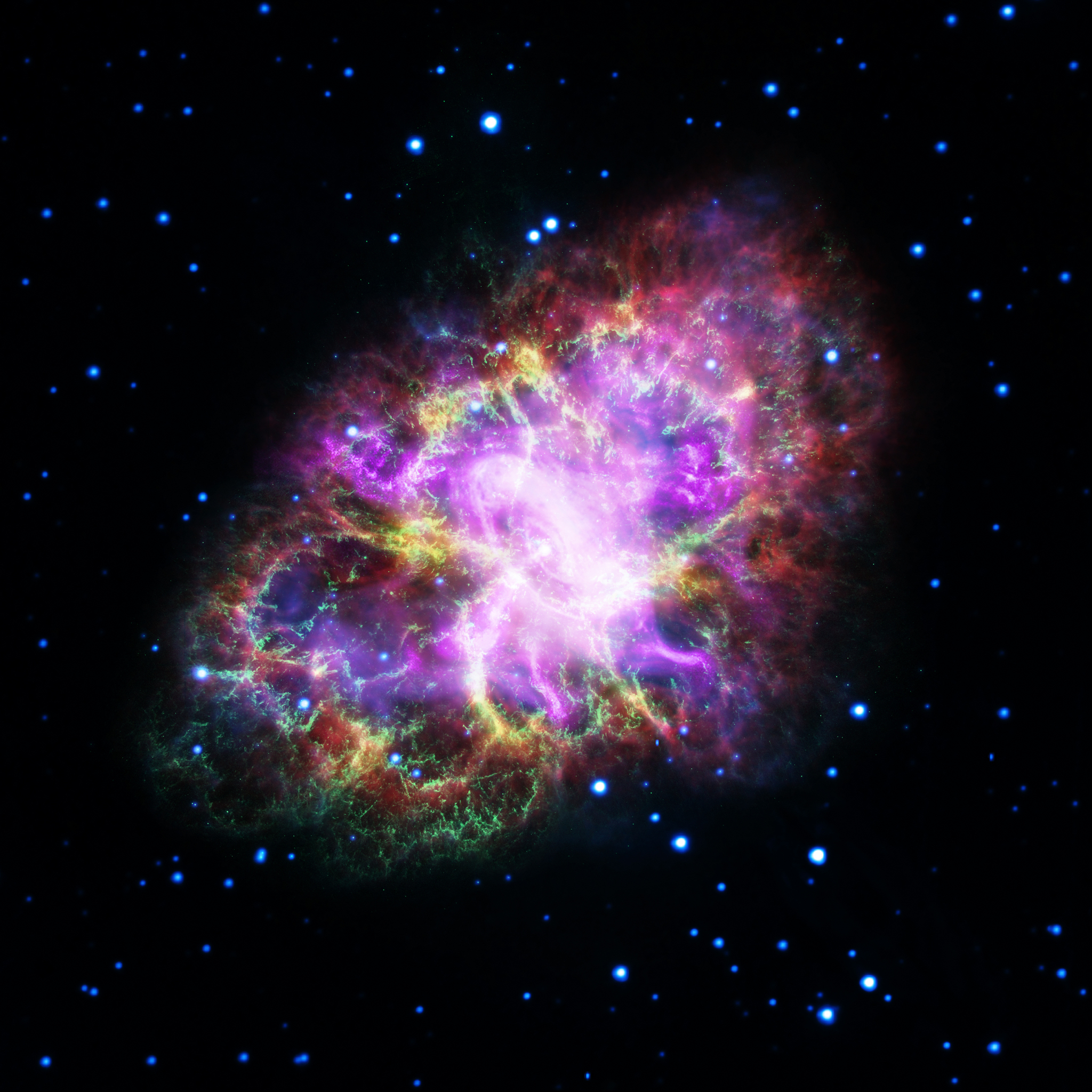
The Multiwavelength Crab
Image Credit: NASA, ESA, G. Dubner (IAFE, CONICET-University of Buenos Aires) et al.;
A. Loll et al.; T. Temim et al.; F. Seward et al.; VLA/NRAO/AUI/NSF; Chandra/CXC;
Spitzer/JPL-Caltech; XMM-Newton/ESA; Hubble/STScI
Explanation: The Crab Nebula is cataloged as M1, the first object on Charles Messier's famous list of things which are not comets. In fact, the Crab is now known to be a supernova remnant, expanding debris from massive star's death explosion, witnessed on planet Earth in 1054 AD. This brave new image offers a 21st century view of the Crab Nebula by presenting image data from across the electromagnetic spectrum as wavelengths of visible light. From space, Chandra (X-ray) XMM-Newton (ultraviolet), Hubble (visible), and Spitzer (infrared), data are in purple, blue, green, and yellow hues. From the ground, Very Large Array radio wavelength data is in shown in red. One of the most exotic objects known to modern astronomers, the Crab Pulsar, a neutron star spinning 30 times a second, is the bright spot near picture center. Like a cosmic dynamo, this collapsed remnant of the stellar core powers the Crab's emission across the electromagnetic spectrum. Spanning about 12 light-years, the Crab Nebula is 6,500 light-years away in the constellation Taurus.

The Multiwavelength Crab
Image Credit: NASA, ESA, G. Dubner (IAFE, CONICET-University of Buenos Aires) et al.;
A. Loll et al.; T. Temim et al.; F. Seward et al.; VLA/NRAO/AUI/NSF; Chandra/CXC;
Spitzer/JPL-Caltech; XMM-Newton/ESA; Hubble/STScI
Explanation: The Crab Nebula is cataloged as M1, the first object on Charles Messier's famous list of things which are not comets. In fact, the Crab is now known to be a supernova remnant, expanding debris from massive star's death explosion, witnessed on planet Earth in 1054 AD. This brave new image offers a 21st century view of the Crab Nebula by presenting image data from across the electromagnetic spectrum as wavelengths of visible light. From space, Chandra (X-ray) XMM-Newton (ultraviolet), Hubble (visible), and Spitzer (infrared), data are in purple, blue, green, and yellow hues. From the ground, Very Large Array radio wavelength data is in shown in red. One of the most exotic objects known to modern astronomers, the Crab Pulsar, a neutron star spinning 30 times a second, is the bright spot near picture center. Like a cosmic dynamo, this collapsed remnant of the stellar core powers the Crab's emission across the electromagnetic spectrum. Spanning about 12 light-years, the Crab Nebula is 6,500 light-years away in the constellation Taurus.

panosol- Αριθμός μηνυμάτων : 762
Points : 927
Reputation : 15
Ημερομηνία εγγραφής : 17/06/2012
Ηλικία : 56
 2017 May 12
2017 May 12
2017 May 12

M13: The Great Globular Cluster in Hercules
Image Credit & Copyright: Adam Block, Mt. Lemmon SkyCenter, U. Arizona
Explanation: In 1716, English astronomer Edmond Halley noted, "This is but a little Patch, but it shews itself to the naked Eye, when the Sky is serene and the Moon absent." Of course, M13 is now less modestly recognized as the Great Globular Cluster in Hercules, one of the brightest globular star clusters in the northern sky. Telescopic views reveal the spectacular cluster's hundreds of thousands of stars. At a distance of 25,000 light-years, the cluster stars crowd into a region 150 light-years in diameter. Approaching the cluster core upwards of 100 stars could be contained in a cube just 3 light-years on a side. For comparison, the closest star to the Sun is over 4 light-years away. Along with the cluster's dense core, the outer reaches of M13 are highlighted in this sharp color image. The cluster's evolved red and blue giant stars show up in yellowish and blue tints.

M13: The Great Globular Cluster in Hercules
Image Credit & Copyright: Adam Block, Mt. Lemmon SkyCenter, U. Arizona
Explanation: In 1716, English astronomer Edmond Halley noted, "This is but a little Patch, but it shews itself to the naked Eye, when the Sky is serene and the Moon absent." Of course, M13 is now less modestly recognized as the Great Globular Cluster in Hercules, one of the brightest globular star clusters in the northern sky. Telescopic views reveal the spectacular cluster's hundreds of thousands of stars. At a distance of 25,000 light-years, the cluster stars crowd into a region 150 light-years in diameter. Approaching the cluster core upwards of 100 stars could be contained in a cube just 3 light-years on a side. For comparison, the closest star to the Sun is over 4 light-years away. Along with the cluster's dense core, the outer reaches of M13 are highlighted in this sharp color image. The cluster's evolved red and blue giant stars show up in yellowish and blue tints.

panosol- Αριθμός μηνυμάτων : 762
Points : 927
Reputation : 15
Ημερομηνία εγγραφής : 17/06/2012
Ηλικία : 56
 2017 May 13
2017 May 13
2017 May 13

Planet Aurora
Image Credit: Scott Kelly, Expedition 44, NASA
Explanation: What bizarre alien planet is this? It's planet Earth of course, seen from the International Space Station through the shimmering glow of aurorae. About 400 kilometers (250 miles) above Earth, the orbiting station is itself within the upper realm of the auroral displays. Aurorae have the signature colors of excited molecules and atoms at the low densities found at extreme altitudes. Emission from atomic oxygen dominates this view. The eerie glow is green at lower altitudes, but a rarer reddish band extends above the space station's horizon. Also visible from the planet's surface, this auroral display began during a geomagnetic storm. The storm was triggered after a coronal mass ejection impacted Earth's magnetosphere in June of 2015.

Planet Aurora
Image Credit: Scott Kelly, Expedition 44, NASA
Explanation: What bizarre alien planet is this? It's planet Earth of course, seen from the International Space Station through the shimmering glow of aurorae. About 400 kilometers (250 miles) above Earth, the orbiting station is itself within the upper realm of the auroral displays. Aurorae have the signature colors of excited molecules and atoms at the low densities found at extreme altitudes. Emission from atomic oxygen dominates this view. The eerie glow is green at lower altitudes, but a rarer reddish band extends above the space station's horizon. Also visible from the planet's surface, this auroral display began during a geomagnetic storm. The storm was triggered after a coronal mass ejection impacted Earth's magnetosphere in June of 2015.

panosol- Αριθμός μηνυμάτων : 762
Points : 927
Reputation : 15
Ημερομηνία εγγραφής : 17/06/2012
Ηλικία : 56
 2017 May 14
2017 May 14
2017 May 14
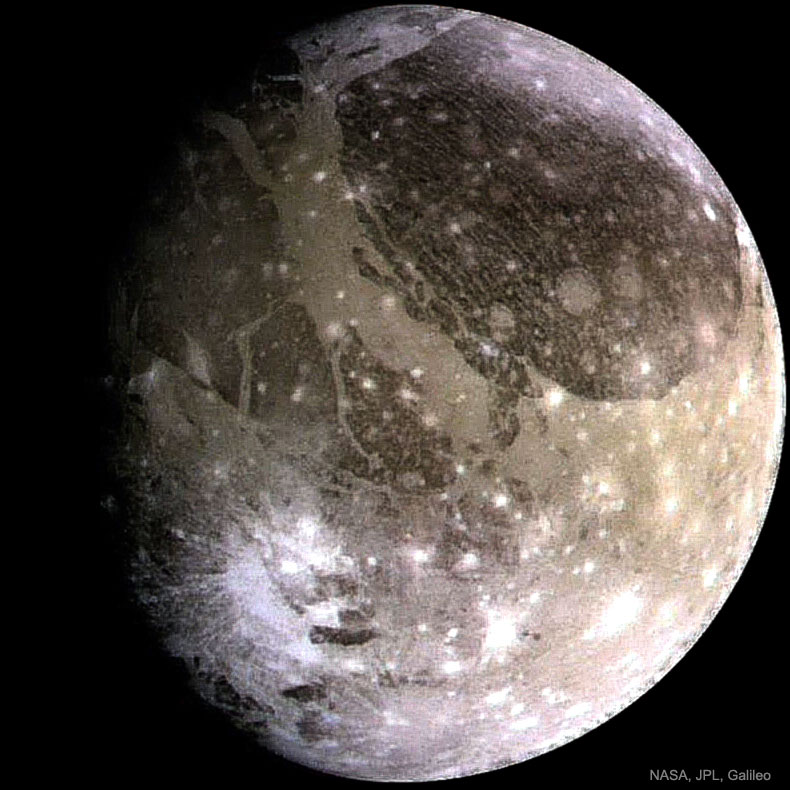
Ganymede: The Largest Moon
Image Credit: NASA, JPL, Galileo Probe
Explanation: What does the largest moon in the Solar System look like? Jupiter's moon Ganymede, larger than even Mercury and Pluto, has an icy surface speckled with bright young craters overlying a mixture of older, darker, more cratered terrain laced with grooves and ridges. The large circular feature on the upper right, called Galileo Regio, is an ancient region of unknown origin. Ganymede is thought to have an ocean layer that contains more water than Earth and might contain life. Like Earth's Moon, Ganymede keeps the same face towards its central planet, in this case Jupiter. The featured image was taken about 20 years ago by NASA's Galileo probe, which ended its mission by diving into Jupiter's atmosphere in 2003. Currently, NASA's Juno spacecraft orbits Jupiter and is studying the giant planet's internal structure, among many other attributes.

Ganymede: The Largest Moon
Image Credit: NASA, JPL, Galileo Probe
Explanation: What does the largest moon in the Solar System look like? Jupiter's moon Ganymede, larger than even Mercury and Pluto, has an icy surface speckled with bright young craters overlying a mixture of older, darker, more cratered terrain laced with grooves and ridges. The large circular feature on the upper right, called Galileo Regio, is an ancient region of unknown origin. Ganymede is thought to have an ocean layer that contains more water than Earth and might contain life. Like Earth's Moon, Ganymede keeps the same face towards its central planet, in this case Jupiter. The featured image was taken about 20 years ago by NASA's Galileo probe, which ended its mission by diving into Jupiter's atmosphere in 2003. Currently, NASA's Juno spacecraft orbits Jupiter and is studying the giant planet's internal structure, among many other attributes.

panosol- Αριθμός μηνυμάτων : 762
Points : 927
Reputation : 15
Ημερομηνία εγγραφής : 17/06/2012
Ηλικία : 56
 2017 May 15
2017 May 15
2017 May 15
Lightning Storm Moves Across the USA
Image Credit: NOAA, NASA, Lockheed Martin, GOES-16, GLM
Explanation: Watch a huge lightning storm move across the eastern USA. The huge storm caused much damage and unfortunately some loss of life for people in its path. Seen from space, the lightning is seen as momentary flashes in the featured time-lapse video recorded last month by the Geostationary Lightning Mapper (GLM) aboard the GOES-16 satellite. The outline of North America is most evident during the day, while the bright lightning strikes are most evident at night. Inspection of the video shows that much of the lightning occurred at the leading edge of the huge tail of the swirling storm. Because lightning frequently precedes a storm's most violent impact, lightning data from GLM holds promise to help reduce the harm to humans from future storms. [/center]

panosol- Αριθμός μηνυμάτων : 762
Points : 927
Reputation : 15
Ημερομηνία εγγραφής : 17/06/2012
Ηλικία : 56
 2017 May 16
2017 May 16
2017 May 16
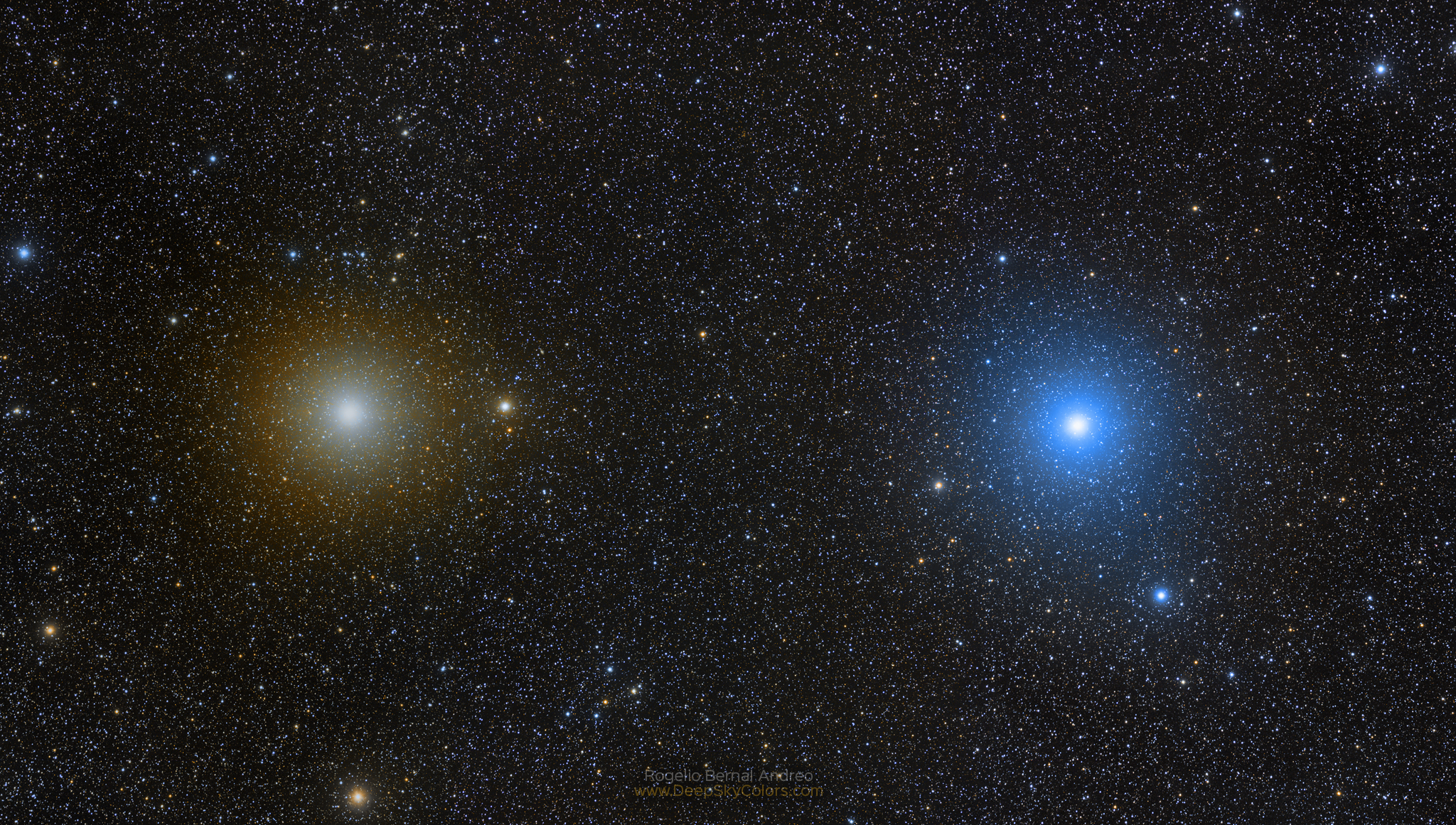
Gemini Stars Pollux and Castor
Image Credit & Copyright: Rogelio Bernal Andreo (Deep Sky Colors)
Explanation: Who are the twins of Gemini? It terms of astronomical objects, the famous constellation is dominated by two bright stars: Pollux (left) and Castor (right). Pictured, the two stars stand out because they are so bright, so close together both in angle and brightness, but so different in color. Pollux, at 33 light years distant, is an evolved red giant star twice as massive as our Sun. Castor, at 51 light years distant, is a blue main sequence star about 2.7 times more massive that our Sun. Castor is known to have at least two stellar companions, while Pollux is now known to be circled by at least one massive planet. In terms of ancient Babylonian, Greek, and Roman mythology, Castor and Pollux represent twin brothers. Currently, the Earth's orbit is causing the Sun to appear to shift in front of the constellation of Gemini, with the result that, for much of humanity, Castor and Pollux will remain visible toward the west at sunset for only a few more weeks.

Gemini Stars Pollux and Castor
Image Credit & Copyright: Rogelio Bernal Andreo (Deep Sky Colors)
Explanation: Who are the twins of Gemini? It terms of astronomical objects, the famous constellation is dominated by two bright stars: Pollux (left) and Castor (right). Pictured, the two stars stand out because they are so bright, so close together both in angle and brightness, but so different in color. Pollux, at 33 light years distant, is an evolved red giant star twice as massive as our Sun. Castor, at 51 light years distant, is a blue main sequence star about 2.7 times more massive that our Sun. Castor is known to have at least two stellar companions, while Pollux is now known to be circled by at least one massive planet. In terms of ancient Babylonian, Greek, and Roman mythology, Castor and Pollux represent twin brothers. Currently, the Earth's orbit is causing the Sun to appear to shift in front of the constellation of Gemini, with the result that, for much of humanity, Castor and Pollux will remain visible toward the west at sunset for only a few more weeks.

panosol- Αριθμός μηνυμάτων : 762
Points : 927
Reputation : 15
Ημερομηνία εγγραφής : 17/06/2012
Ηλικία : 56
Σελίδα 6 από 15 •  1 ... 5, 6, 7 ... 10 ... 15
1 ... 5, 6, 7 ... 10 ... 15 
Σελίδα 6 από 15
Δικαιώματα σας στην κατηγορία αυτή
Δεν μπορείτε να απαντήσετε στα Θέματα αυτής της Δ.Συζήτησης|
|
|

 Αρχική
Αρχική Φόρουμ
Φόρουμ RADIO
RADIO ΠΑΙΓΝΙΔΙΑ
ΠΑΙΓΝΙΔΙΑ Latest images
Latest images Εγγραφή
Εγγραφή Σύνδεση
Σύνδεση




» ΚΑΛΗ ΑΝΑΣΤΑΣΗ ΚΑΙ ΚΑΛΟ ΠΑΣΧΑ!!
» Εφυγε από τη ζωή ο Τζίμης Πανούσης
» ΧΡΟΝΙΑ ΠΟΛΛΑ ΚΑΙ ΚΑΛΗ ΧΡΟΝΙΑ ΜΕ ΥΓΕΙΑ ΚΑΙ ΕΥΤΥΧΙΑ!!!
» This day in music
» Astronomy Picture of the Day
» Τις καλύτερες ευχές μου για Ευτυχισμένα Χριστούγεννα σε όλους!!
» ΖΗΤΩ Η 28η ΟΚΤΩΒΡΙΟΥ 1940
» ΖΗΤΩ Η 28η ΟΚΤΩΒΡΙΟΥ 1940
» Το τελευταίο αντίο στη Ζωή Λάσκαρη
» 19 Μαΐου: Ημέρα Μνήμης της Γενοκτονίας των Ποντίων
» Kαλό σου ταξίδι!!
» ΧΡΙΣΤΟΣ ΑΝΕΣΤΗ!!
» ΚΑΛΗ ΜΕΓΑΛΗ ΕΒΔΟΜΑΔΑ!!
» ΚΑΛΟ ΜΗΝΑ!!!
» ΧΡΟΝΙΑ ΠΟΛΛΑ!!
» ΧΡΟΝΙΑ ΠΟΛΛΑ!!
» R.I.P. Chuck Berry
» 8 Μαρτίου - Παγκόσμια Ημέρα της Γυναίκας
» ΧΡΟΝΙΑ ΠΟΛΛΑ ΚΑΙ ΚΑΛΗ ΣΑΡΑΚΟΣΤΗ!!